Many thanks to those who joined Forgotten Chicago for our tenth season of events, our most diverse and far-reaching yet!
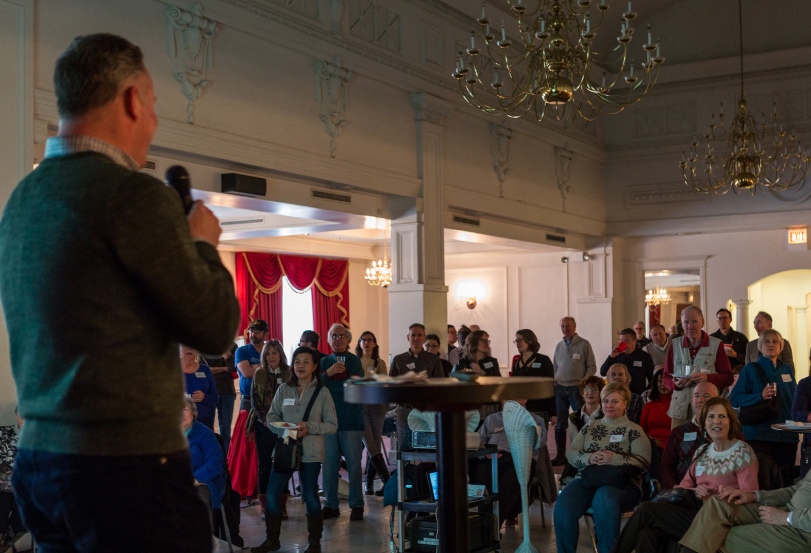
Matthew Kaplan
A group of 150 celebrated Forgotten Chicago’s tenth anniversary on Sunday, February 11, 2018 during FC10x10, our one-time-only event held at Michelle’s Ballroom in Avondale. Seen above is Terry Banich during the event’s first segment, discussing our ten favorite research resources on Chicago area history and the built environment. Terry is author of Forgotten Chicago’s two most popular features, Remnants of the “L” that was published in 2011 and The Bloomingdale Line, published in 2012.
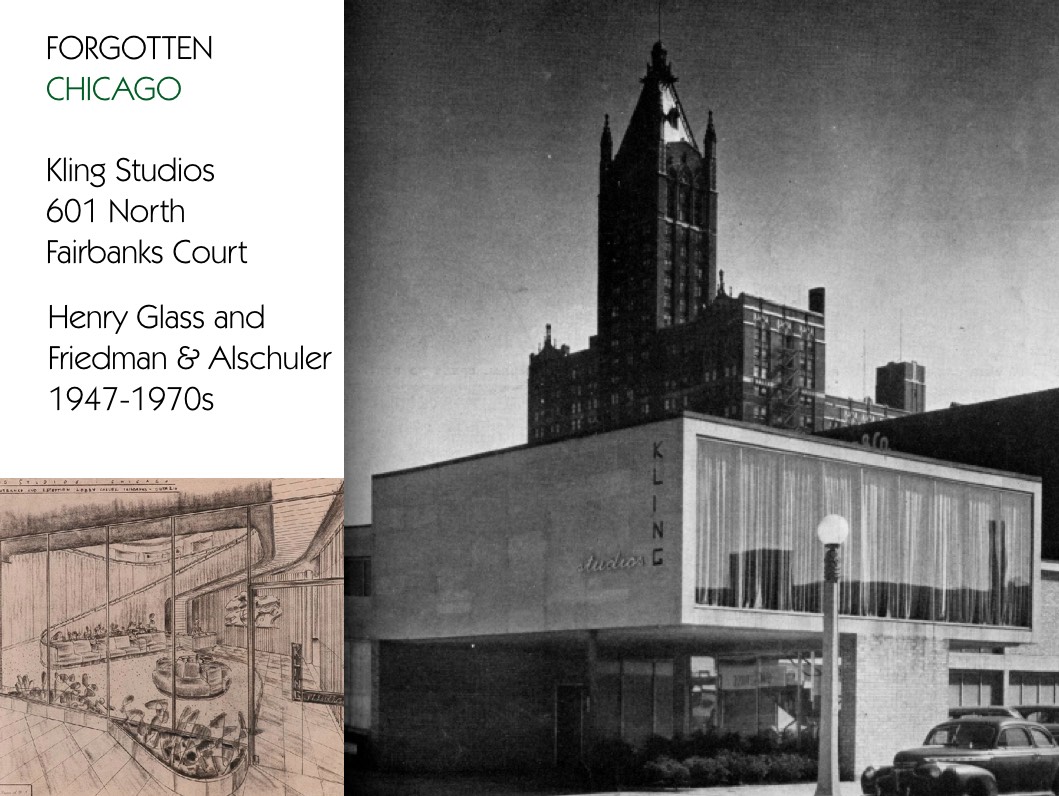
Lower Left: Art Institute of Chicago Right: Architectural Forum, 1947
Our selection for forgotten landmarks include Kling Studios in Streeterville, a leading advertising agency that led the marketing effort for Chicago’s bid for the 1952 Summer Olympics. Kling’s studio building was designed by Friedman, Alschuler & Sincere, with interiors by Henry Glass. Demolished in the 1970s, photographs of this stunning Modernist landmark are not known to have been republished in more than 70 years.
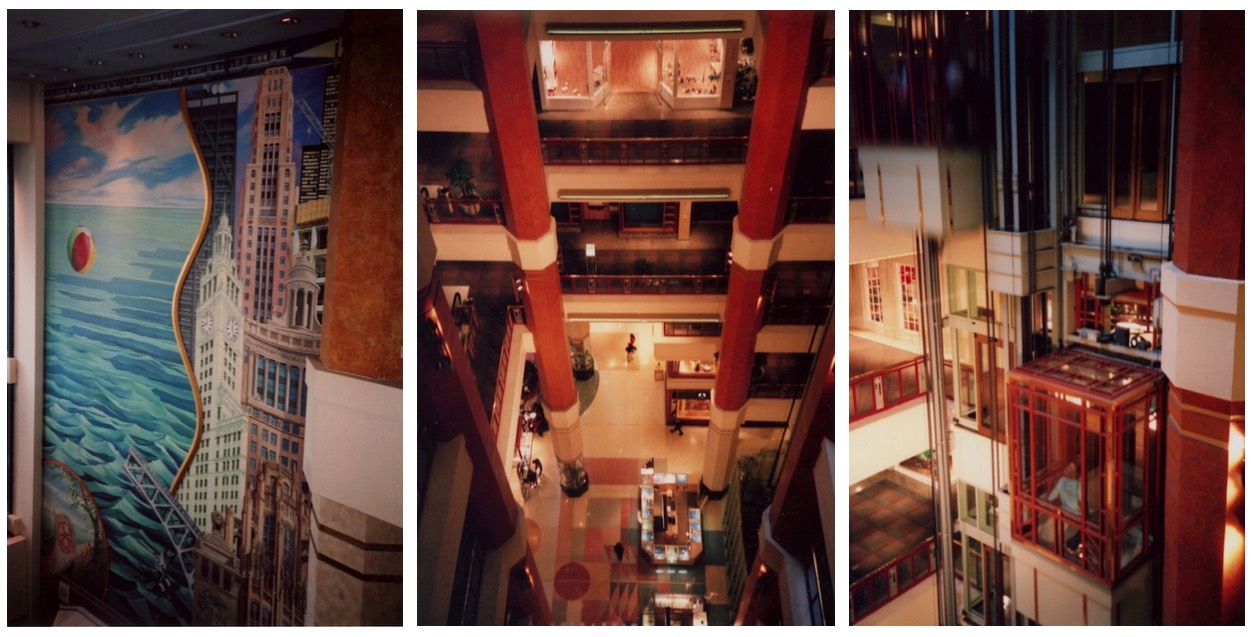
Patrick Steffes, 2007
Also discussed were the most overlooked architects and designers that contributed to the built environment of the Chicago area. Included was Deborah Sussman (1931-2014), whose Prairie Style-inspired interior and color scheme of Chicago Place Mall was the key visual feature of this 1990 vertical shopping mall. This mall portion above the first floor has been closed and abandoned since 2009, with the flanking murals by Thomas Melvin shown above left that are no longer visible in retail stores for T-Mobile and prior to that, All Saints.

Patrick Steffes
Another portion of the presentation was Forgotten Chicago’s most notable research discoveries, including a previously unknown project by Bertrand Goldberg demolished in 2016, Chicago’s first Postmodern building and a long-forgotten industrial canal in the Gold Coast. Our proprietary research materials include 35,000 images, articles and scanned ephemera with 60GB of data; Forgotten Chicago photographs and scans non-indexed and non-digitized publications, including real estate and retail magazines, trade journals and local ephemera.

Joe Sislow
FC10x10 also included a presentation by Forgotten Chicago Contributor Joe Sislow on what we call Future Forgotten, the digital and printed material so critical to future researchers but unlikely to be saved, archived or digitized by any other organization. Examples of Forgotten Chicago and our contributors growing collection of local ephemera include a 1981 dessert menu from the Windy City Gay Chorus above left and an Alderman Dick Simpson 44th Ward cookbook from 1971, featuring the baked chicken Ida Turkel prepared for her husband Studs.

Scorched Earth Brewing Company and Red Apple Buffet
Held at Michelle’s Ballroom in Avondale, a former bank and nut company headquarters, this event included an extensive beer selection from Algonquin’s Scorched Earth Brewing; information on Scorched Earth’s beer, tap room and brewery tours may be found here. In addition, Chicago’s famed Red Apple Buffet provided delicious canapés and deserts from their Avondale restaurant. With an additional location in Norwood Park, Red Apple Buffet has been serving the highest the quality foods from the Old Country for more than 25 years, winning multiple awards and devoted fans along the way.
Many thanks to all those who joined us at FC10x10!
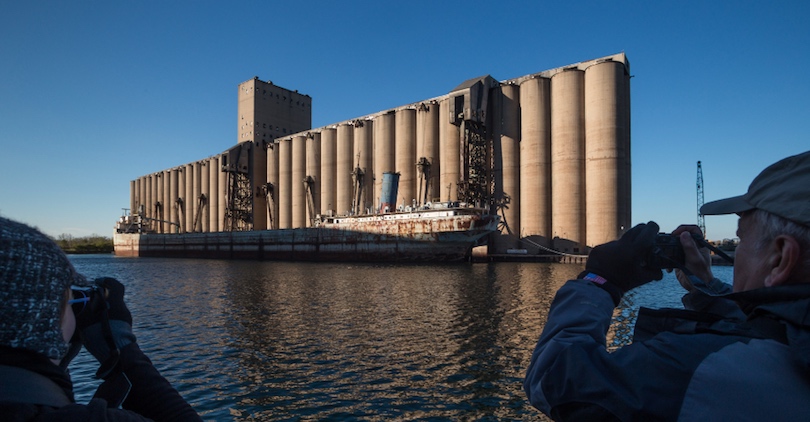
Matthew Kaplan
For Forgotten Chicago’s tenth anniversary season in 2017, we offered several all-new tours and presentations, most never offered by any other organization. We explored some of the countless overlooked corners of the Chicago region, including South Shore, the Illinois Medical District, Lake Calumet (above) and the Calumet River, Gage Park, and much, much more.
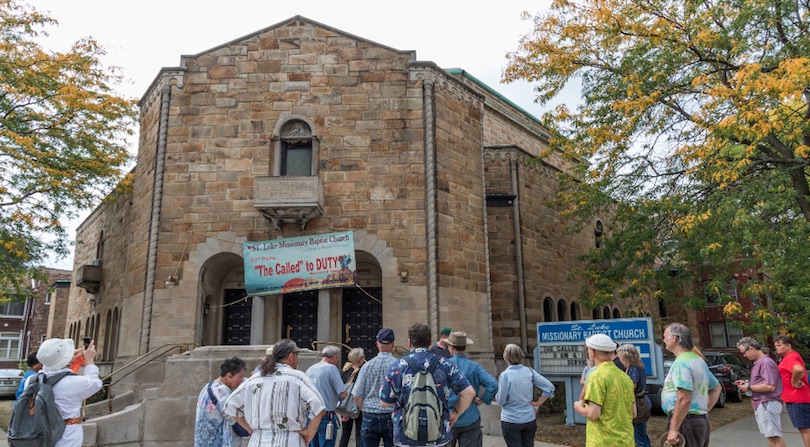
Matthew Kaplan
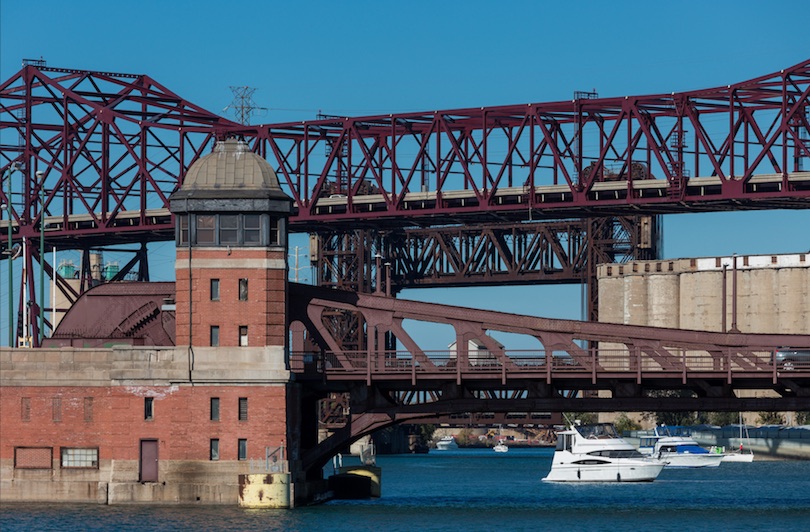
Matthew Kaplan
Of particular note during our 2017 season were two tours visiting the vast and often-overlooked history and industrial landscape of Northwest Indiana and the Calumet Region, including a boat tour of the spectacular Calumet River and Lake Calumet that got up close to an awesome array of bridges, infrastructure and industry. Additional information on this boat tour, and many more stunning photos, may be seen below.
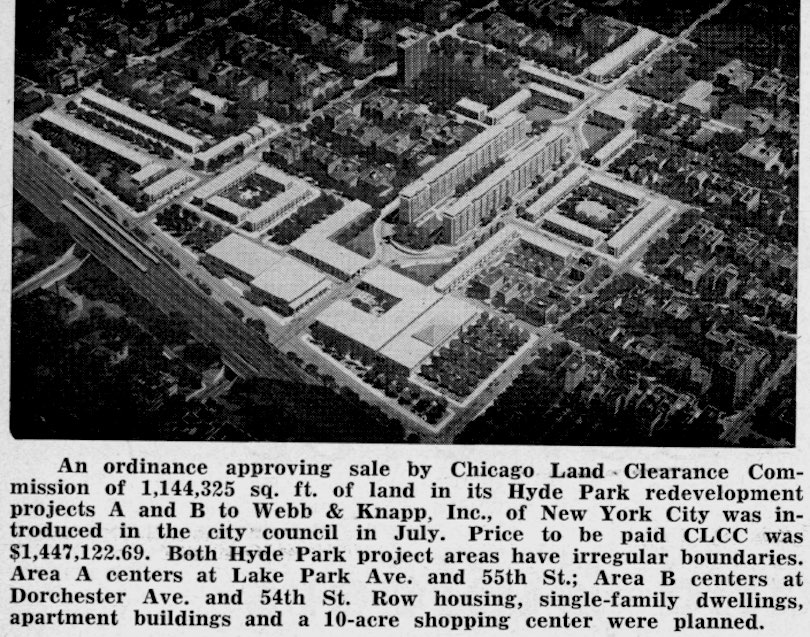
Realty & Building, 1958
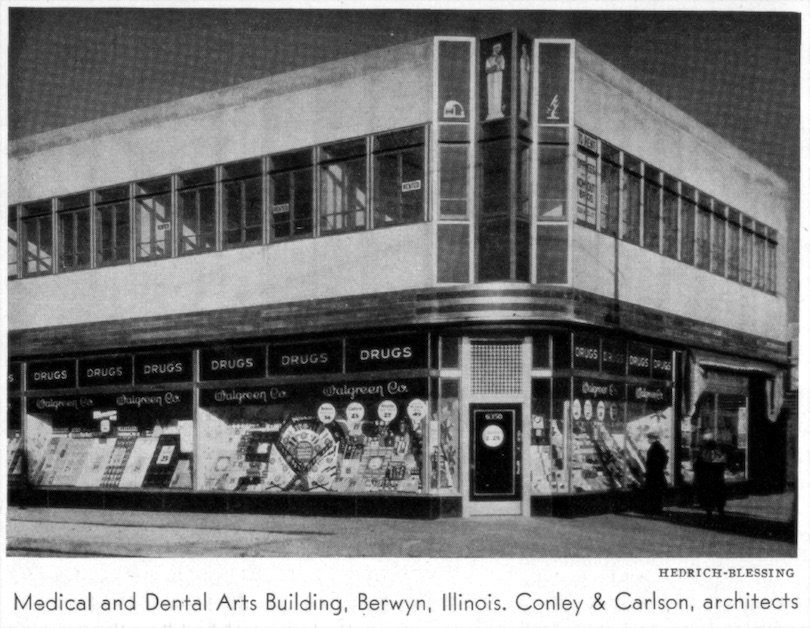
American Architect, 1933
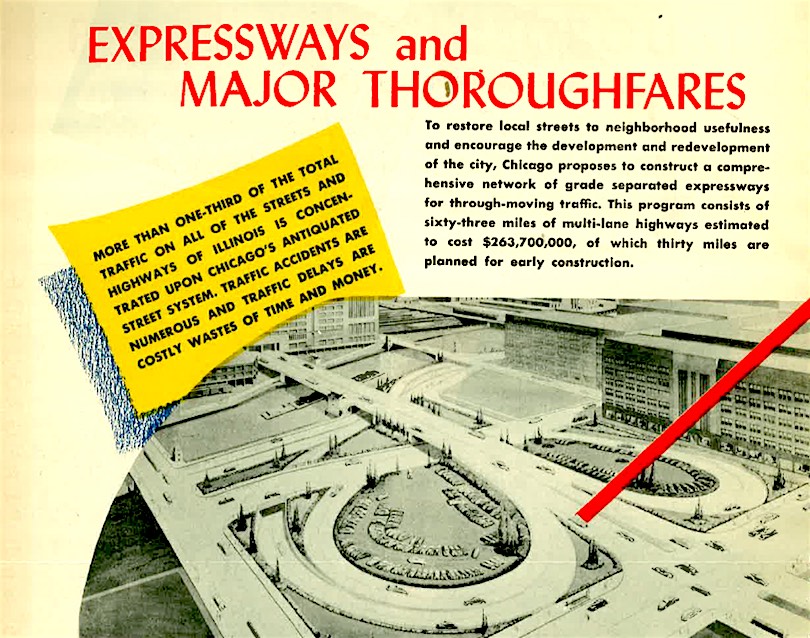
Chicago Looks Ahead: Design for Public Improvements, 1945
In 2016, Forgotten Chicago explored three often-overlooked areas north of the Chicago Loop, and on Sunday, August 13 we closely examined the area just southwest of the Loop around the Jane Byrne Interchange. The region’s highway system was contemplated for decades before being realized starting in the early 1950s, and one of the key components of the entire system is the Jane Byrne Interchange, a vital component of the region’s multi-billion dollar economy and transportation network.
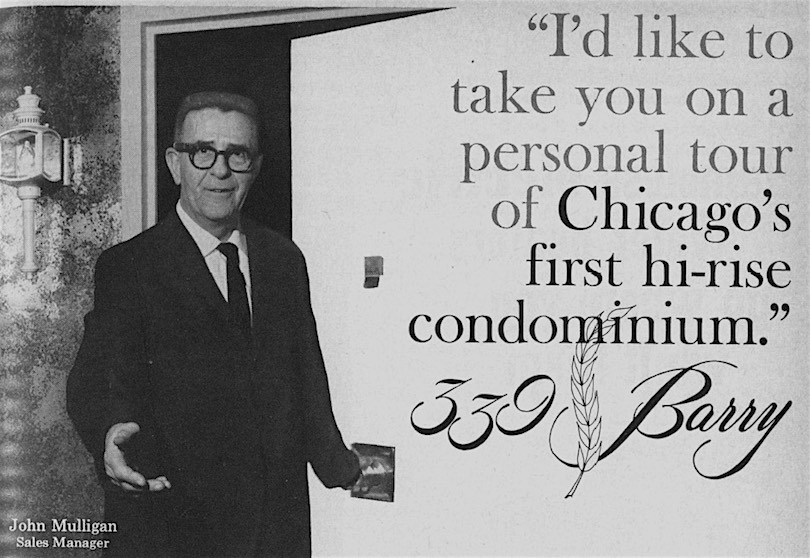
Commerce, 1965
In the last fifty years, countless high-rise condominium buildings have been built in the Chicago area, but only one building was the first. Opened in April, 1964 by architects Fridstein & Fitch, this building may qualify as one of the most significant, if overlooked, buildings in Chicago. Forgotten Chicago’s Lake View tour on Sunday, September 24 walked past this non-landmark landmark building, who’s distinctive script seen above was still extant at the entrance to this condominium during the tour, more than 50 years after forever changing Chicago development.
To be notified of upcoming events, please sign up for our email list on the FC homepage if you want to be the first to know when they go on sale.

Architectural Forum, 1936
On Sunday, November 12, 2017 Forgotten Chicago was pleased to offer a reprise of our Clearing/Ford City bus tour, offered for the first time since 2013. In collaboration with the Clear-Ridge Historical Society, we conducted a bus tour of the Clearing area of the Southwest Side — an early example of an industrial suburb. We rolled past industrial history, curious remnants and sites that were critical to Allied war production during World War II. Little studied but an integral part of the history of Chicago, the 1900 Clearing Industrial District is one of the earliest and most important examples of a planned industrial park – the predecessor to the suburban industrial parks now commonly found along the interstates.

Curtiss-AllBrite Lighting Company ad, 1960
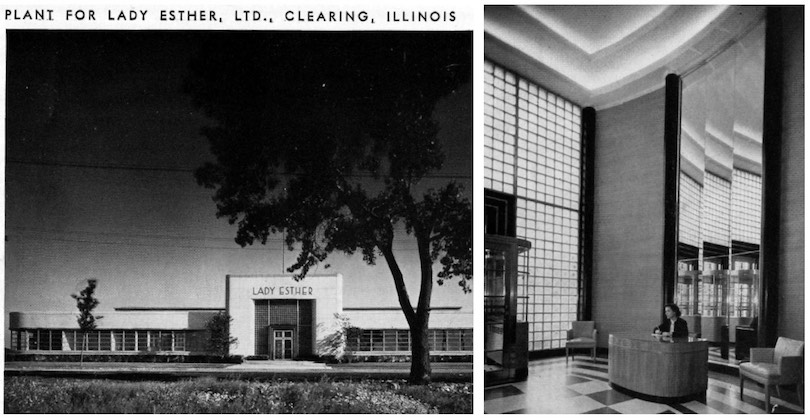
Architectural Forum, 1938
Unlike the often-uninspired buildings found in these modern-day parks, the factory buildings at Clearing were designed with architectural details and quality construction that announced with pride the products they once produced. Master industrial architect Albert Kahn, best known for factories from the Soviet Union to Michigan also produced a stunning Art Deco factory and office for Lady Esther cosmetics as seen above that remains intact, though drastically altered, today.
Positioned beside a huge Belt Railway yard, Clearing was an ideal place for industry to locate. It once housed hundreds of companies producing everything from linoleum flooring to toothpaste; Clearing was an important economic engine for the Chicago area. While it has changed drastically over the years, much of its history is still evident. The tour will roll by factories of architectural note, buildings that once churned out products known to people all over the country, and other remnants of Chicago’s industrial age.
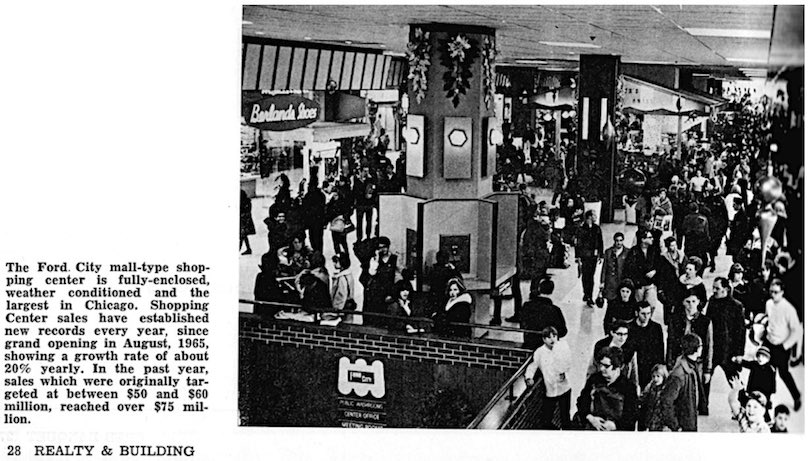
Realty & Building, 1970
Furthermore, this tour rolled past the historic Clearing commercial district and residential neighborhoods that housed factory workers. We explored Chrysler Village, built for defense workers at the nearby Dodge Chicago plant (later Ford City). The tour drove past the former town hall building, a remnant from Clearing’s brief existence as an independent village before annexation to Chicago in 1915. Local transportation was an important part of the development of Clearing; we investigted the hiding-in-plain-sight remnants of the streetcar that once served the area.
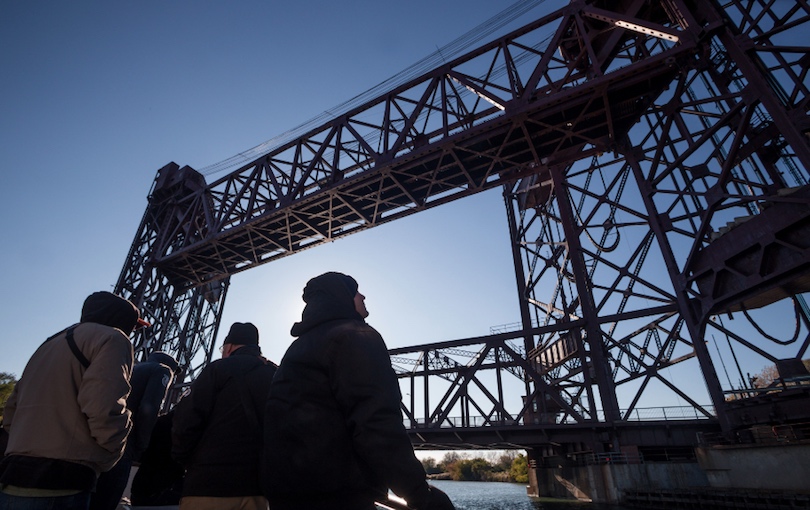
Matthew Kaplan
On a glorious and cloudless Sunday, October 29, 2017, Forgotten Chicago’s conducted a reprise of our sold-out and exclusive Calumet Region boat tour. Featuring unlimited beer and wine and an extensive buffet on a deluxe charter boat, we were thrilled to share these often-overlooked but spectacular waterways with our guests.
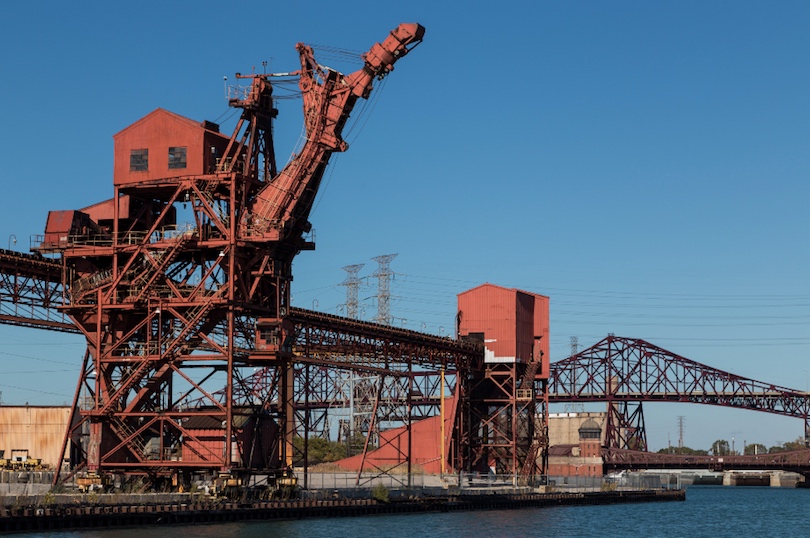
Matthew Kaplan
Much of the region’s still-extant industrial infrastructure stands directly on the Calumet River, including an enormous unloading device used to service industries along the river. The Calumet (later Chicago) Skyway opened in 1958 and towers 125 feet over the Calumet River, an engineering and construction marvel that took far less time to complete than the Navy Pier Flyover.
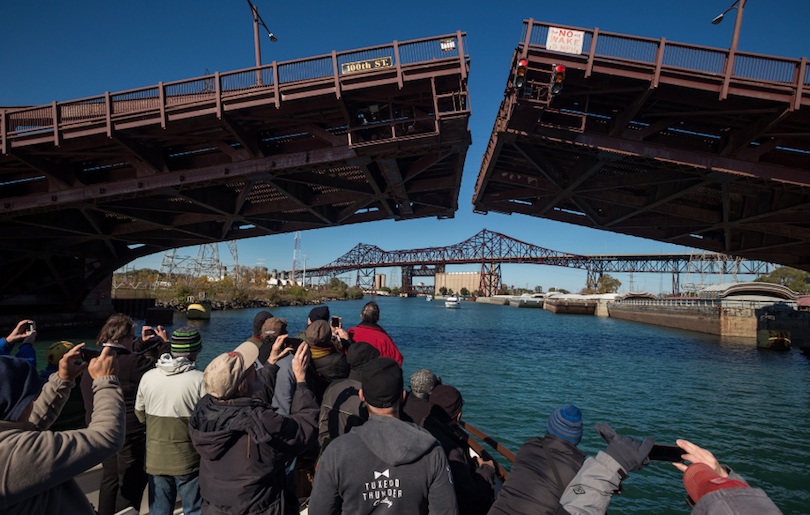
Matthew Kaplan
Numerous bascule lift bridges, including the East 100th Street span seen above were passed under and opened for our charter boat. Unlike the Chicago River, virtually no tours are conducted on the Calumet River, despite the river’s fascinating history and stunning scenery.
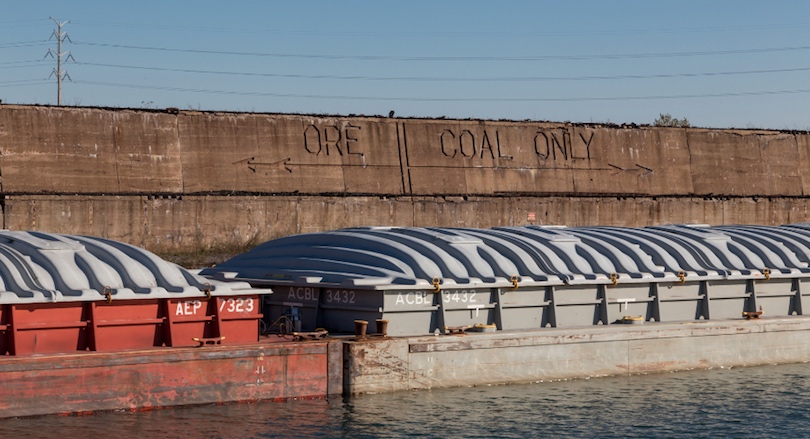
Matthew Kaplan
Remnants of the area’s industrial past (and present) abound in the Calumet Region, including the Torrence Avenue Assembly Plant, Ford Motor Company’s oldest continually operating vehicle assembly plant (since 1924, not shown above).
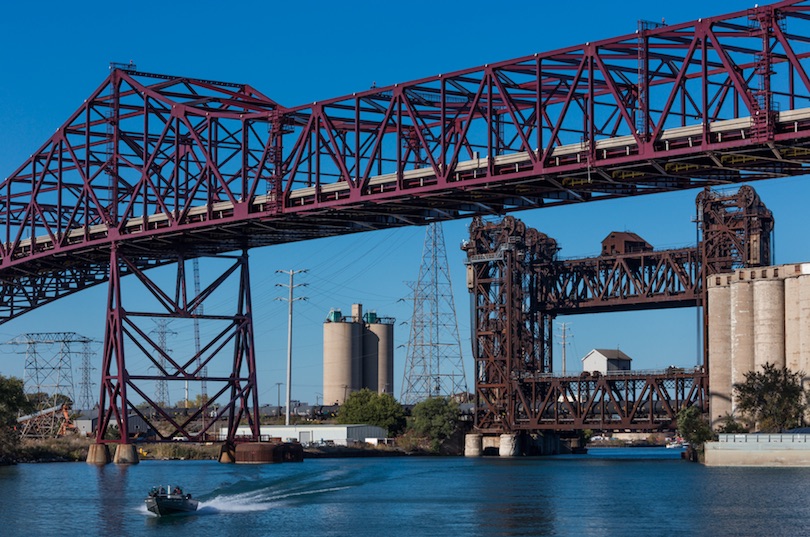
Matthew Kaplan
The massive height and scale of the Chicago Skyway can only been seen from the Calumet River. Behind it may be seen a multi-track vertical railroad lift bridge, another Calumet Region landmark.

Matthew Kaplan
For the first time, we ventured into Lake Calumet to see more industrial landmarks including long-abandoned former grain silos and a permanently moored freighter, both testaments to the vast array of industry and industrial uses of the area.
Many thanks to all those who joined us in exploring the history of the Calumet Region!

Left: Wikipedia Right: Joe Sislow
On Saturday, October 21, 2017, Forgotten Chicago gave an all-new and exclusive presentation on Chicago’s decades-long role in the global pinball, arcade, and video game industry at the Bezazian Branch of the Chicago Public Library. We discussed Chicago’s rich pinball industry, which would later give birth to the arcade industry, as well as why these industries located and thrived for decades in the Chicago area.
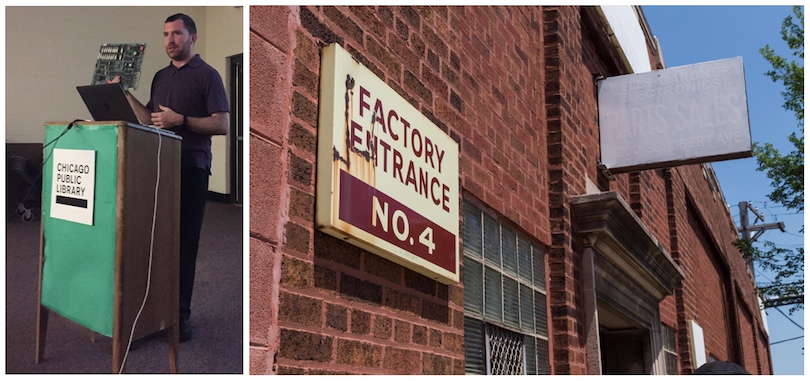
Left: Patrick Steffes Right: Matthew Kaplan
Our presentation discussed the designers, companies, and physical locations of these manufacturers, including buildings that are still standing to this day. One example is the former Wells-Gardner factory in Pennock, visited several times during Forgotten Chicago walking tours. Every video monitor built for every Pac-Man arcade machine sold in the U.S. was made here; the company sign may still been seen above right.
Many thanks to Friends of Bezazian Library, who made this program possible, and to those who joined us in Uptown!
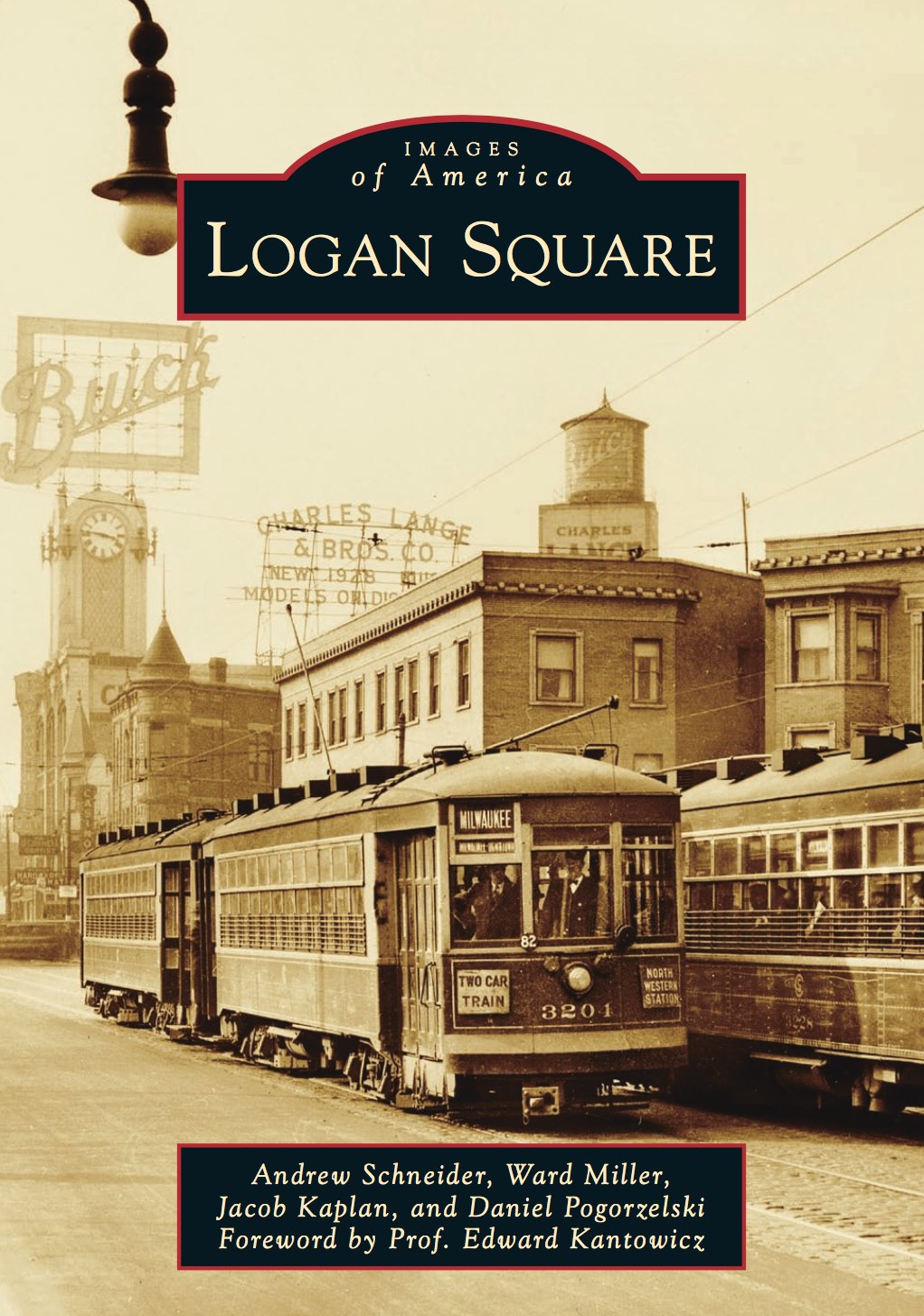
A sold-out group joined Forgotten Chicago on Sunday, October 1, 2017 for an encore of our in-depth tour of Logan Square, covering the social history and built environment of one of Chicago’s most fascinating neighborhoods. Coinciding with the forthcoming release of the brand-new book Images of America: Logan Square, co-authored by Forgotten Chicago co-founder Jacob Kaplan and editor Daniel Pogorzelski, this tour explored the successive waves of development and redevelopment in a community that is currently undergoing gentrification and rapid physical change.
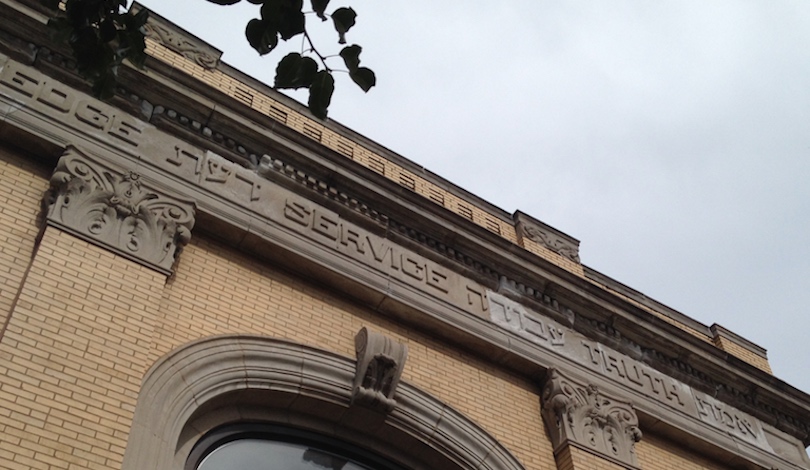
Patrick Steffes
This exclusive tour examined the rich history of the area. We discussed factories that employed hundreds, historic and noteworthy church structures, unique and historic retail architecture, and the housing stock that served many waves of new immigrants. Along the way, we hoped that participants gained new perspectives of how a Chicago neighborhood has developed, changed, and continues to evolve over time.
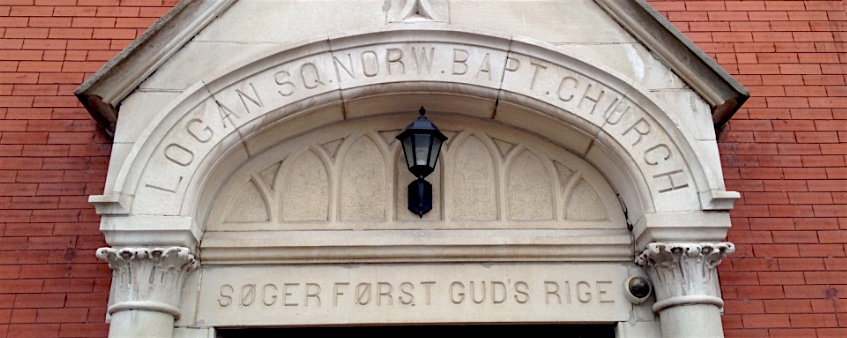
Patrick Steffes
Tour participants also had the opportunity to see the historic Logan Square Boulevard District in detail. We also looked at sites reflecting the area’s ethnic history, a visit inside a church still offering services in Norwegian, and buildings that served new residents from Belarus, Serbia, Puerto Rico, Poland, and many other locations around the world. As with all Forgotten Chicago tours, we also paid special attention to the architectural and infrastructure oddities and curiosities in the built environment.
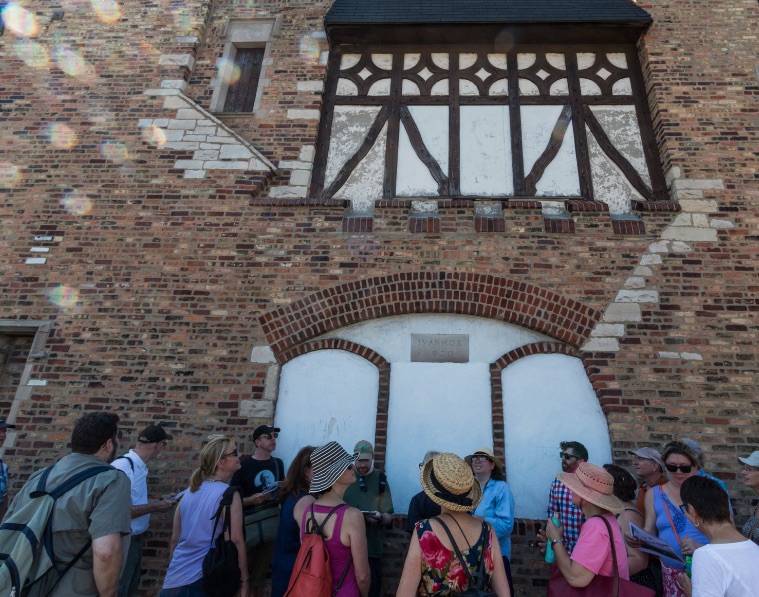
Matthew Kaplan
A lively group joined Forgotten Chicago on a record-breaking 93 degree fall day on Sunday, September 24, 2017 for an encore of our Lake View walking tour that explored this neighborhood’s built environment and the many remnants of the past from curious cornerstones, early twentieth century parking garages, Art Deco storefronts, notable synagogues, to the history of the multiple empty lots on Lake Shore Drive between Oakdale and Waveland. Skipping sports bars, chain stores and a certain athletic field, we closely examined the lesser known and largely forgotten remnants of this ever-changing and fascinating neighborhood.
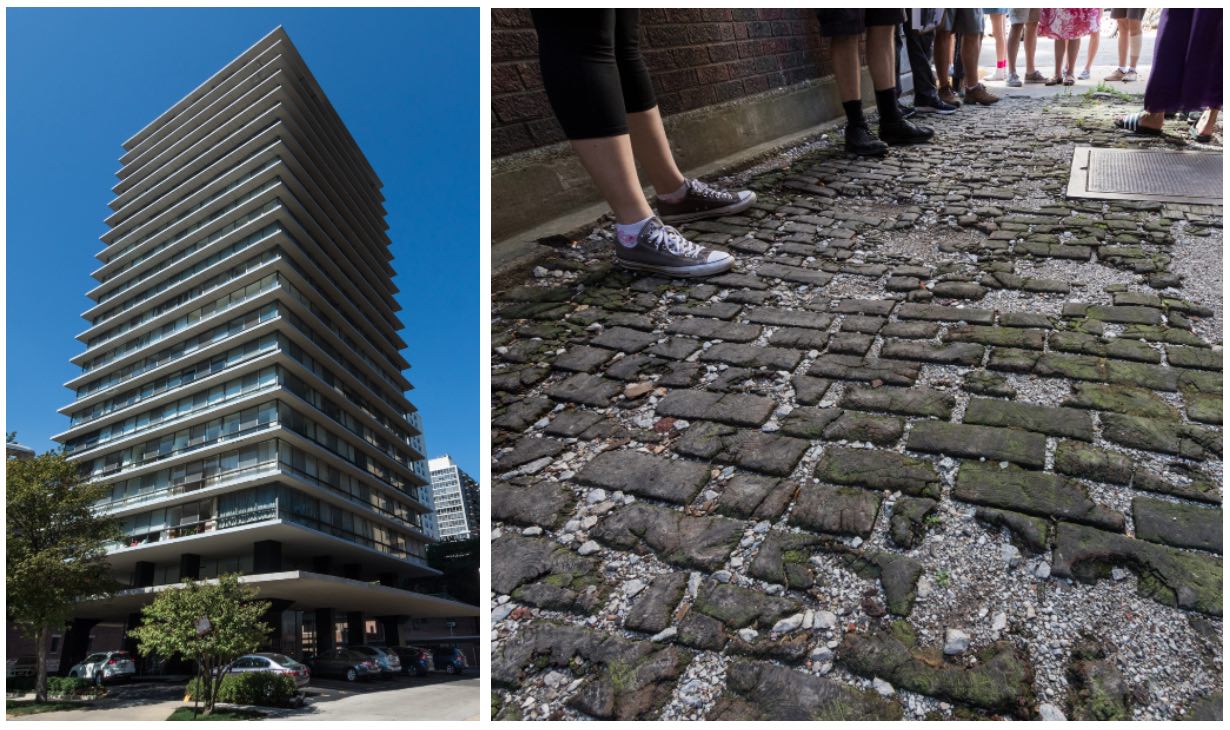
Matthew Kaplan
Visiting no fewer than 35 sites, this tour included everything from a remarkable 1954 apartment building by Milton Schwartz, above left to a rare wood-block alley just steps from Lake Shore Drive and Belmont Harbor, above right. A few of the many highlights will included what may be the world’s oldest (1906) extant former parking garage, an enormous former tabernacle church turned into retail stores, and a famed former German beer garden and dance hall turned into a church that is very much intact today.
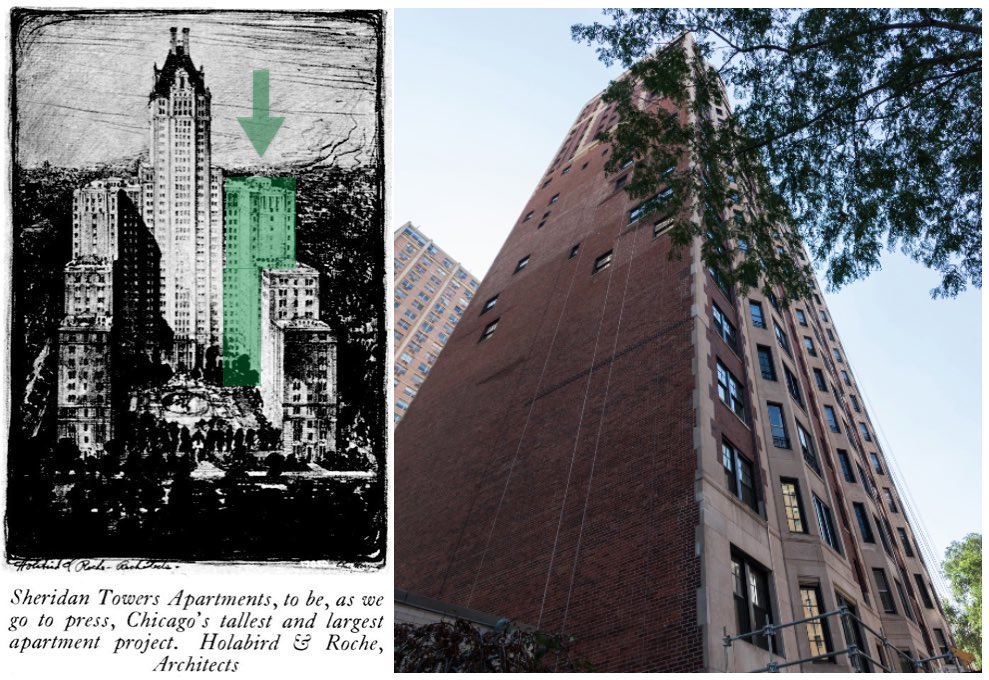
Left: Architecture, 1928 Right: Matthew Kaplan
One of the most jarring examples in the U.S. of the Great Depression, just a small portion of arguably the grandest apartment building ever proposed for Chicago was visited during our Lake View tour. Unfortunately opening in October 1929, what was to be named The Eddystone would go into receivership just 32 months later. Still featuring mostly blank walls facing both Lake Michigan and the Chicago skyline where the building would have met the unbuilt remaining project, the relatively small section of the complex that was completed is highlighted in green above left.
Many thanks to everyone who braved the heat to join us in Lake View!
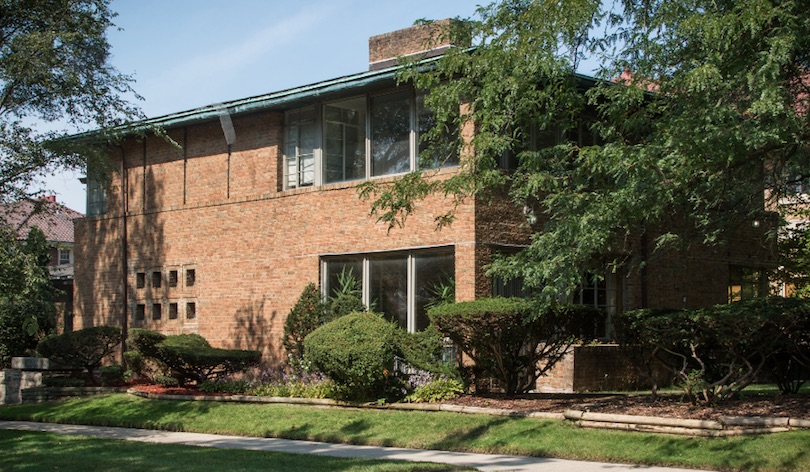
Matthew Kaplan
On Sunday, September 17, 2017 a sold-out group joined Forgotten Chicago for our first-ever tour of the South Shore community area, a neighborhood rich with remnants of Chicago history, development, and architecture. Staring at the Bryn Mawr Metra Station at the corner of Jeffery and East 71st Street, we explored the many elegant houses of the Jackson Highlands area, a Chicago landmark district since 1989. A remarkably intact 1936 home by often-overlooked Chicago modernist architect Paul Schweikher seen above was one of the many highlights in this idyllic neighborhood of towering trees and oversized lots.
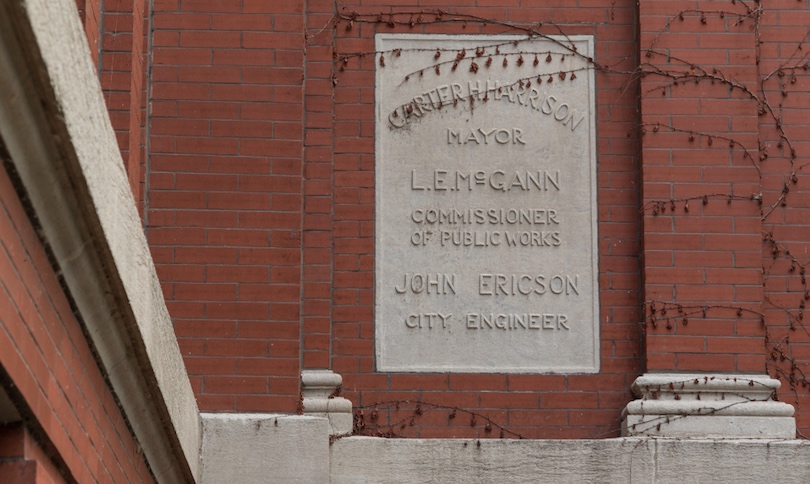
Matthew Kaplan
Notable as one of the few communities in Chicago where residential buildings are sited directly on Lake Michigan, South Shore developed rapidly in the 1910s and 1920s into a very dense neighborhood of high rises, large cooperative and apartment buildings, and other grandiose structures. Also seen during this tour was everything from a forgotten (and mostly intact) 1928 parking garage, the sites of two former Shoreline Motels, and an interior visit to the site of the 1992 wedding reception of Barack and Michelle Obama.
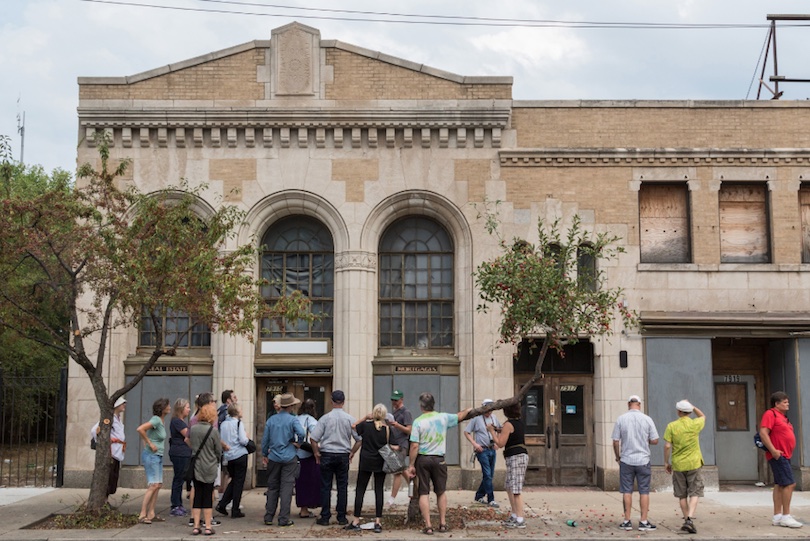
Matthew Kaplan
Appropriately, this tour ended at the former offices of the Charles Ringer Company, a leading developer of the the South Shore. Ringer (1894-1947) was a long-time Republican politician, elected official, and Chairman of the Cook County Board of Assessors from 1927 to 1931. Constructed in 1928 and featuring an imposing two-story lobby, Ringer’s monument to South Shore development and real estate remains remarkably intact nearly 90 years after opening.
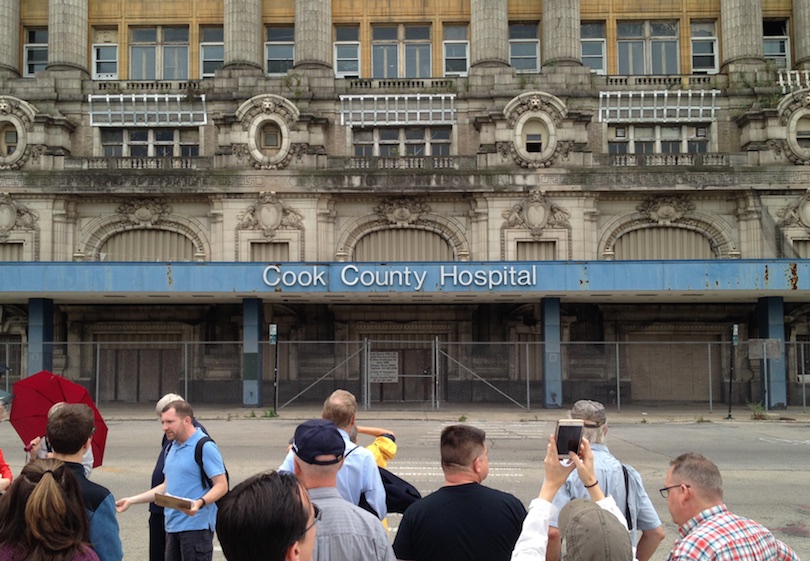
Patrick Steffes
A sold-out group joined Forgotten Chicago on Sunday, August 27, 2017 for our first walking tour of the Illinois Medical District on the Near West Side. One of the earliest areas of large-scale urban renewal in Chicago, the more than 300 acre site of the IMD has been undergoing near continual change and construction since it was established in 1941. Often overlooked by locals and visitors alike, to our knowledge this was the first public walking tour of the IMD’s history, architecture, and notable institutions.

Areas with disparate uses surround the Illinois Medical District, including a public university, the Eisenhower Expressway, and the dense Tri-Taylor community. Many large hospitals began to be located in this area in the late 19th Century (Cook County Hospital among the most known), but later state-sponsored planning began to build the area into a massive development starting in the early 20th Century. Existing structures were demolished, new structures were built, and the area began to take shape as a master-planned area. Architectural styles from Gothic to Art Deco to Mid Century Modern were employed in the area.
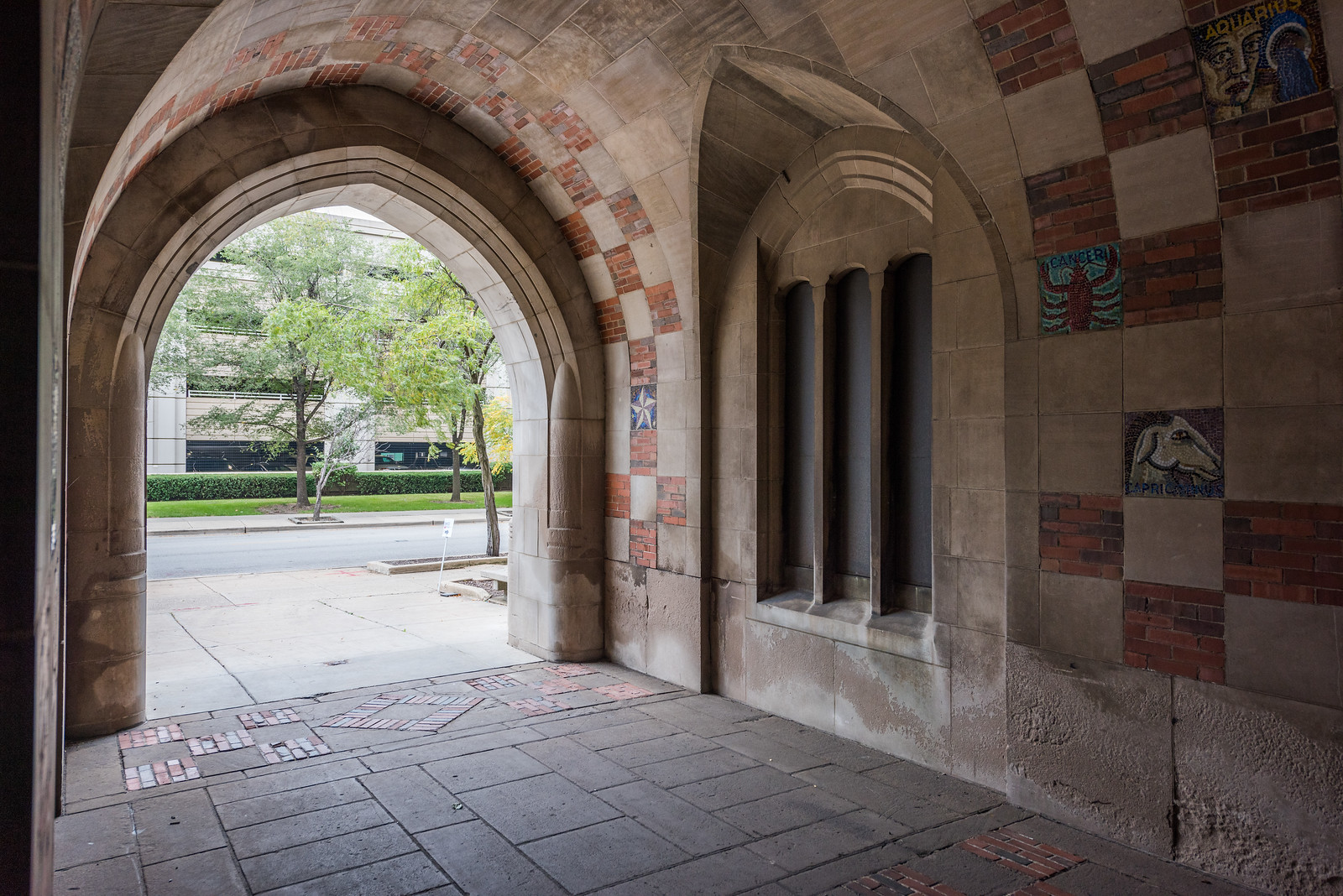
Despite this master planning and urban renewal, the area still includes remnants of its early period when residential and industrial uses were still present. This tour explored these remnants, as well as the fascinating architectural curiosities of the district, including WPA-era mosaics of astrology and celestial symbols as seen above, utterly unexpected in a publically funded institution devoted to science, medicine and research.
Many thanks to those who joined us in exploring the Illinois Medical District!
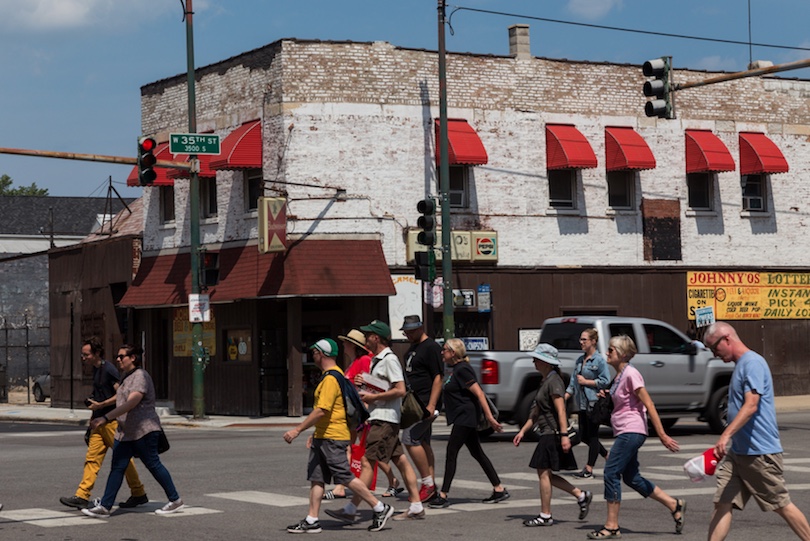
Matthew Kaplan
On Sunday, August 20, 2017 a sold-out group joined Forgotten Chicago for our first walking tour exploring the myriad neighborhoods and community areas on and near West 35th Street, from Bronzeville to McKinley Park. Starting near the Illinois Institute of Technology, this tour explored neighborhoods including “The Gap” in Bronzeville, an area that escaped the urban renewal that was pushed upon much of the rest of the area. We then headed west into Armor Square, past Comiskey Park, and then into Bridgeport, discussing much of the history of that storied community and its political aspirants.
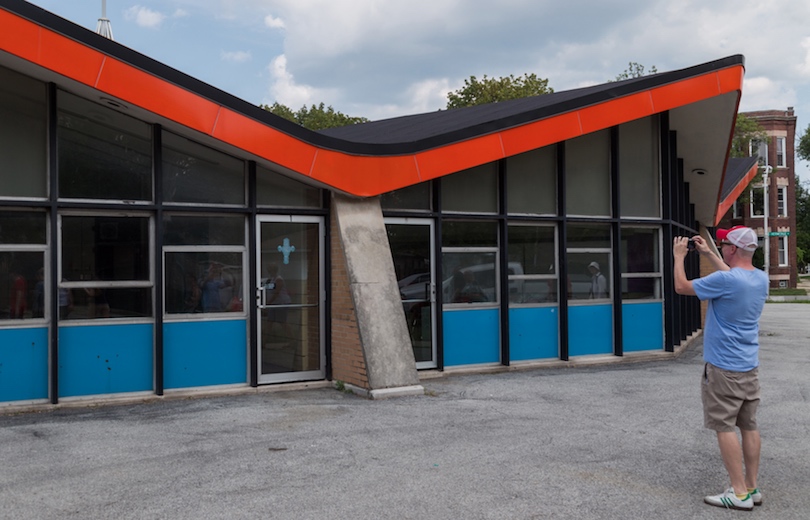
Matthew Kaplan
Chicago is a city defined by its street grid, especially since it has so few natural features. Even moreso, the city is defined by its arterial streets. These streets form borders between neighborhoods, serve as shopping districts, transportation corridors, and generally give the city its character. Curiosities abound, including the 1960 former Our Lady of Good Counsel School building by Kefer & Cronin, whose eight classrooms all directly exit to the outside, an unusual design that was seen as a safety measure following the tragic Our Lady of the Angeles school fire in late 1958.
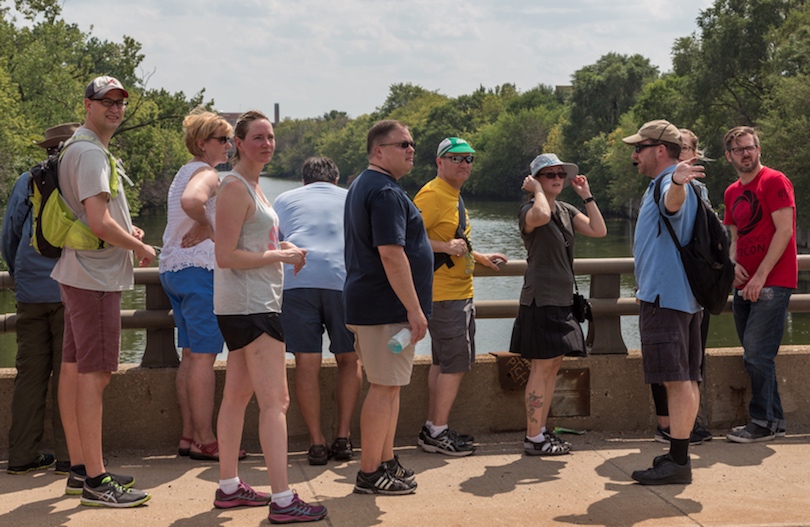
Matthew Kaplan
Along the way, our 35th Street Tour discussed infrastructure, remnants of historic storefronts, industry, signage, and other curiosities, as well as the remnants of one of the first planned-industrial parks in the world. We concluded in the McKinley Park community and the remnants of its historic fabric from the turn of the 20th Century.

Matthew Kaplan
On Sunday, August 13, 2017 a sold-out group joined us for the Jane Byrne Interchange tour, offered for the first time by any organization. In the midst of a $404M reconstruction since 2013, the Jane Byrne Interchange (known as the Circle Interchange until August 2014) is an often-maddening meeting of three of the nation’s busiest roadways, the Dan Ryan, Eisenhower and Kennedy Expressways, as well as Congress Parkway. A highlight of the tour was the new ramp from the inbound Dan Ryan to the westbound Eisenhower seen above and opened in December 2016.
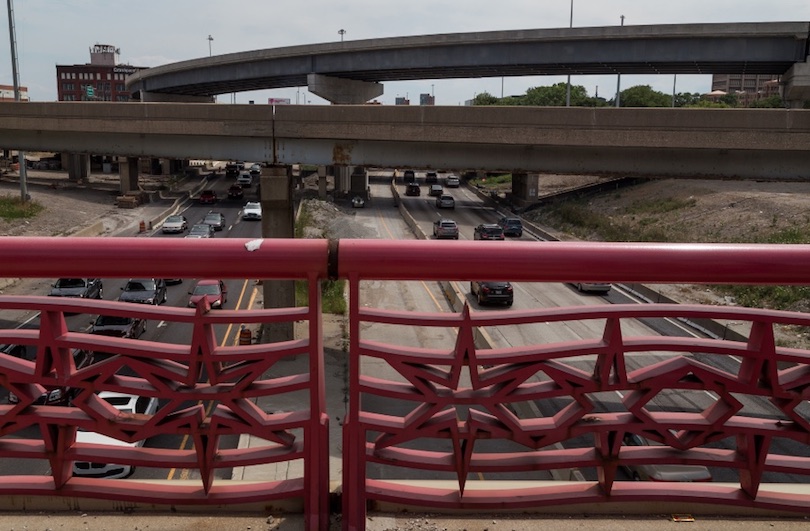
Matthew Kaplan
This tour discussed the role of this interchange in the region’s economy, the vital neighborhoods that were demolished for its construction, and the original infrastructure that remain today, more than 50 years after the interchange was completed in 1962. Also seen was one of the Mayor Richard M. Daley-era bridges spanning the southernmost section of the Kennedy Expressway including the Van Buren Street Bridge, seemingly unmaintained or painted since it was dedicated in 2000.
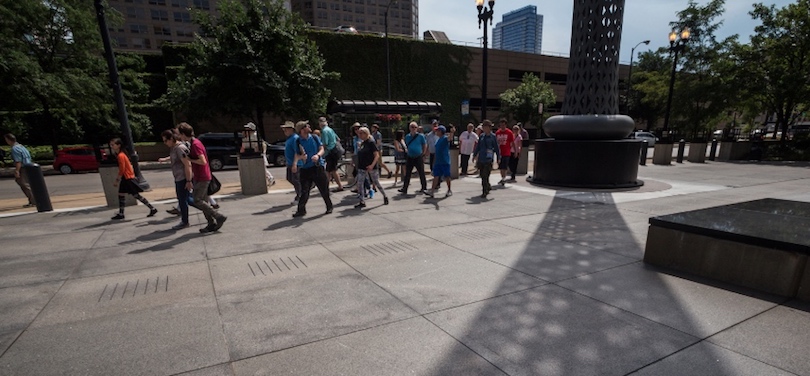
Matthew Kaplan
The Jane Byrne Interchange tour also explored early gentrification in the South Loop, the neighborhoods that were displaced to build the University of Illinois at Chicago, the remnants of UIC’s once-signature skywalk system, a still-standing but endangered former cable car powerhouse from the nineteenth century and the saga of Presidential Towers, a portion of which may be seen in the photo above. Completed in the mid-1980s and originally containing no fewer than 2,346 apartments in four, 49-story buildings, Presidential Towers easily ranks as one of the biggest political and real estate scandals in Chicago history, a project that purportedly cost $200M in tax breaks, defaulted loans and taxpayer subsidies.
Many thanks to old and new friends who joined us on this first-ever tour!

Courtesy of Chicago Jewish Historical Society
Forgotten Chicago was honored to conduct a sold-out motor coach tour of Chicago’s Jewish West Side for the Chicago Jewish Historical Society on Sunday, August 6, 2017. Covering the West Side from the relocated Maxwell Street Market on South Desplaines Avenue to a stop at the Garfield Park Conservatory, this tour explored neighborhoods around UIC, Little Italy, North Lawndale and East Garfield Park. Celebrating their 40th anniversary in 2017, the Chicago Jewish Historical Society offers a wide variety of interesting programs and events for members and guests.
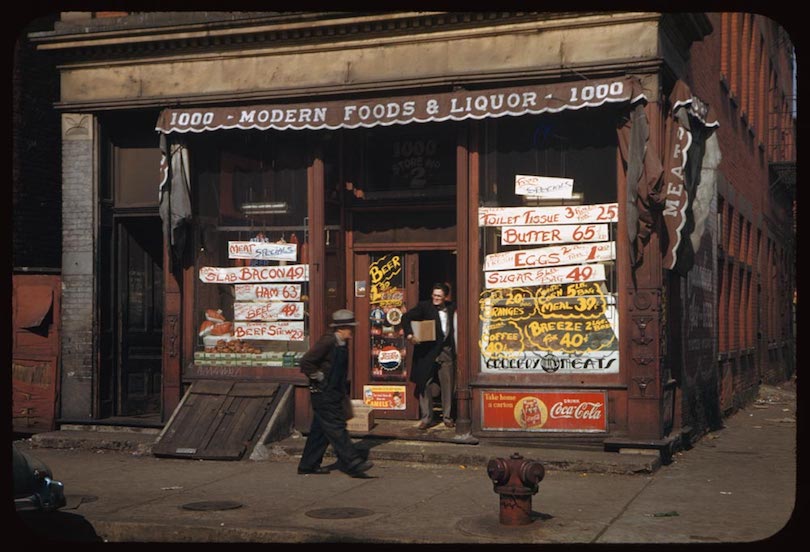
Food and drink store at 1000 Maxwell St, 1949, Charles W. Cushman Photograph Collection, Indiana University Archives
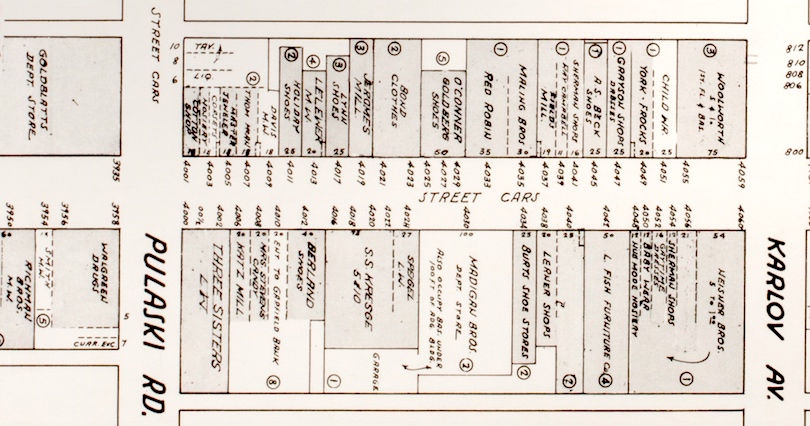
Art Institute of Chicago
Seeing over 60 sites including a visit inside the Jane Addams Hull-House Museum, this tour included locations and remnants integral to Jewish life, culture, business and philanthropy on the West Side. Also visited was one of the many thriving shopping areas in these communities, the Pulaski (formerly Crawford) and Madison district that contained many Jewish-owned institutions such as Goldblatt’s and the Weisner Bros. store as seen in this highly detailed 1954 shopping map.
Many thanks to the participants on this tour!

Patrick Steffes, 2013
A sold-out group joined Forgotten Chicago on Sunday, July 30, 2017 for our exclusive Division Street walking tour, offered for the first time since 2013. Division Street was explored in depth from the Gold Coast to Humboldt Park, with its myriad identities from Paseo Boricua to “Polish Broadway” seen and discussed along the way.
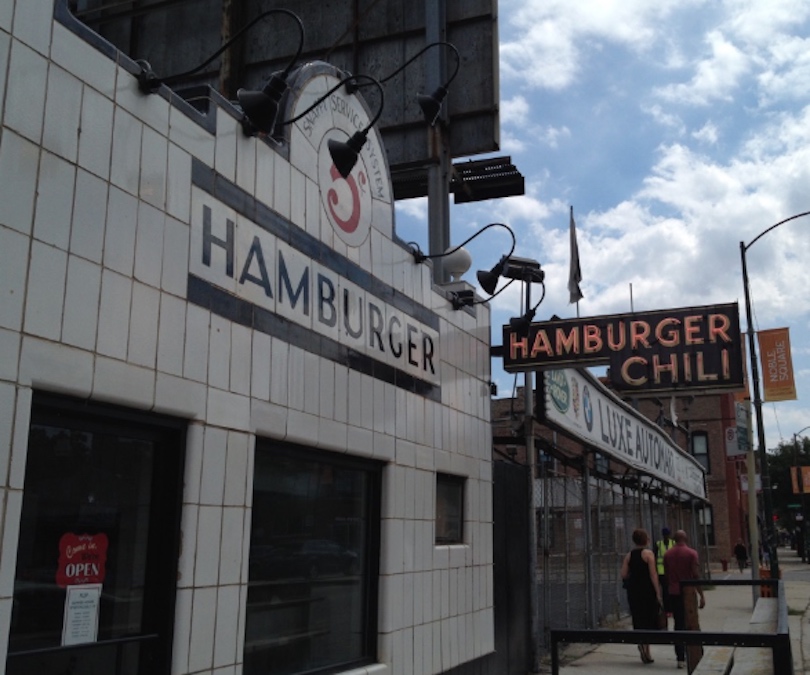
Patrick Steffes
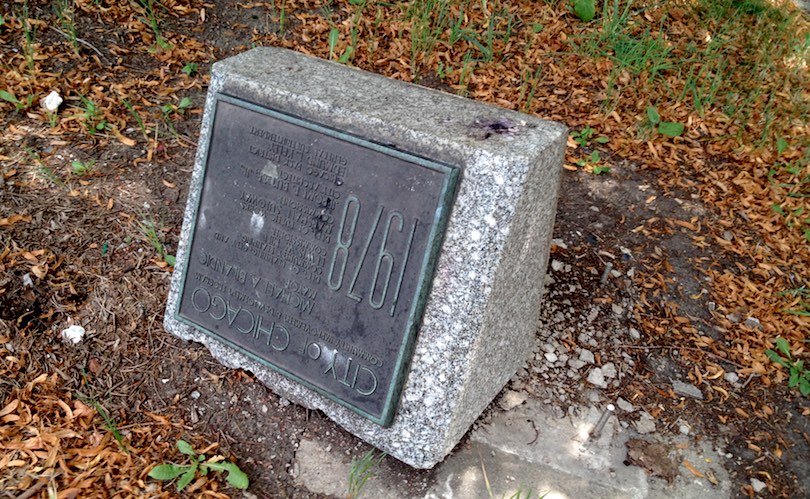
Patrick Steffes
The many incarnations of Division Street’s built environment and rich history were examined, including, the remnants of Cabrini Green, industrial Goose Island, overlooked ethnic enclaves past and present, urban renewal, historic storefronts and more. We also visited a Mayor Bilandic-era Expressway Park facing Division Street, a curious (and forlorn) civic improvement that was discussed in a 2008 Forgotten Chicago article,
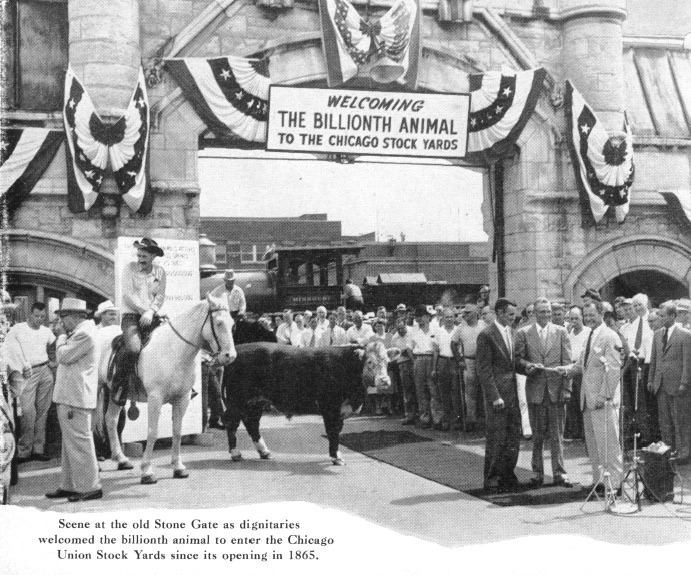
Commerce, 1955
A capacity crowd joined Forgotten Chicago at the Canaryville Branch of the Chicago Public Library on Wednesday, July 19, 2017 for an all-new presentation on this fascinating community. Canaryville’s history was Integral to the Chicago Union Stock Yards that operated between 1865 and 1971, with the one billionth animal grandly welcomed to the world-renowned facility on September 6, 1954 and presumably butchered soon after.
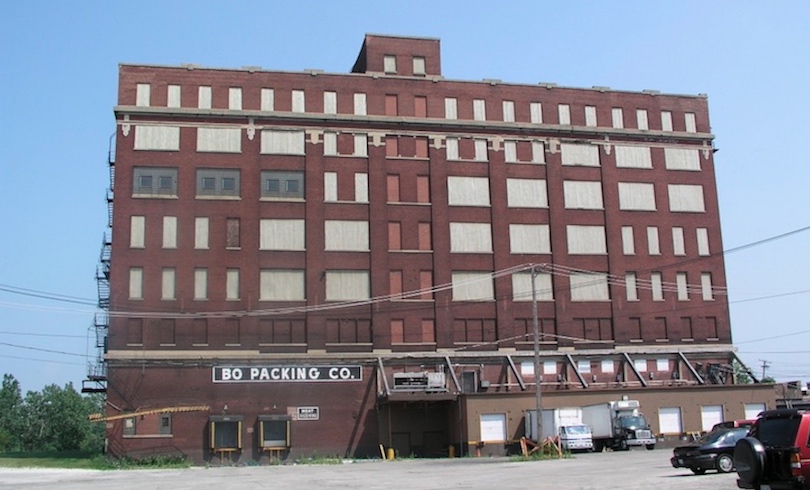
Jacob Kaplan
Despite popular misconception, not everything was demolished at the Stock Yards following its closure in 1971; this all-new presentation highlighted many of the stockyards remnants that remain 45 years later, including offices for Swift & Company seen above. The Union Stock Yards and its massive operations were integral to the history of the Canaryville community, Chicago, and the development of the American industrial economy.
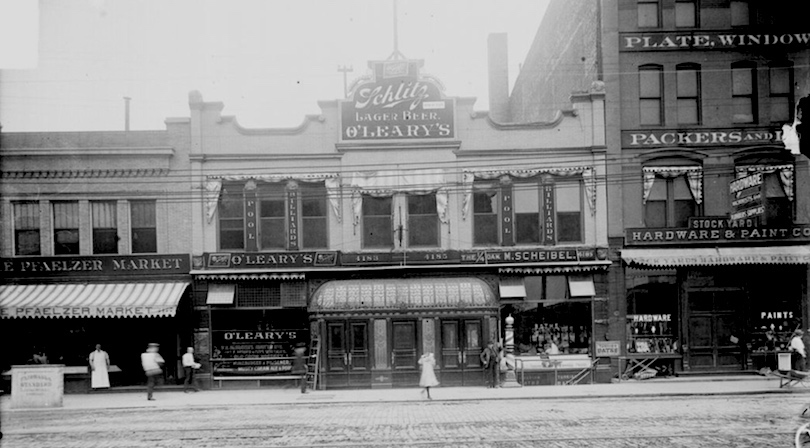
South Halsted Street, Encyclopedia of Chicago, no date
Canaryville and other nearby communities thrived and declined with the rise and fall of the Stock Yards, but today contains a rich array of historical structures, including the nation’s first planned industrial manufacturing district. Many thanks to all those who joined us in Canaryville!
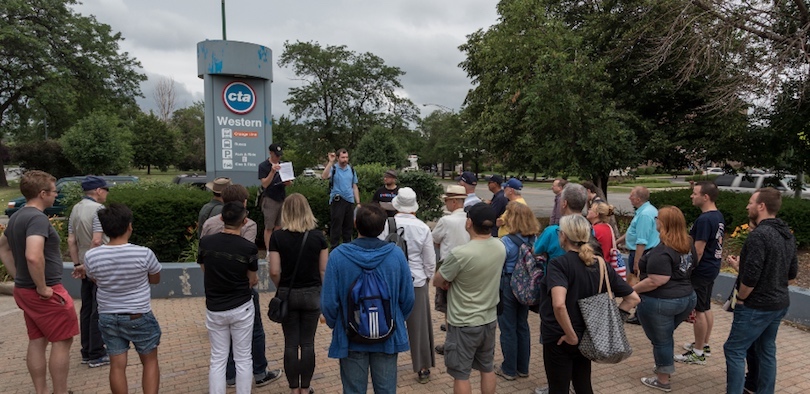
Matthew Kaplan
A sold-out group joined Forgotten Chicago on a delightfully cool summer day on Sunday, July 16, 2017 for our first-ever tour of the fascinating but often forgotten community of Gage Park on Chicago’s Southwest Side. Gage Park is a diverse working-class community that often gets overlooked in the grand scheme of Chicago neighborhoods, but is a great example of an area where growth was spurred on by recreational developments – namely Chicago’s boulevard system and its namesake park, which drew developers to the area in the early 20th Century.
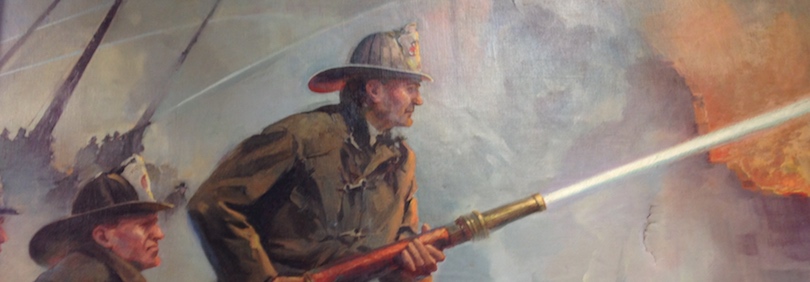
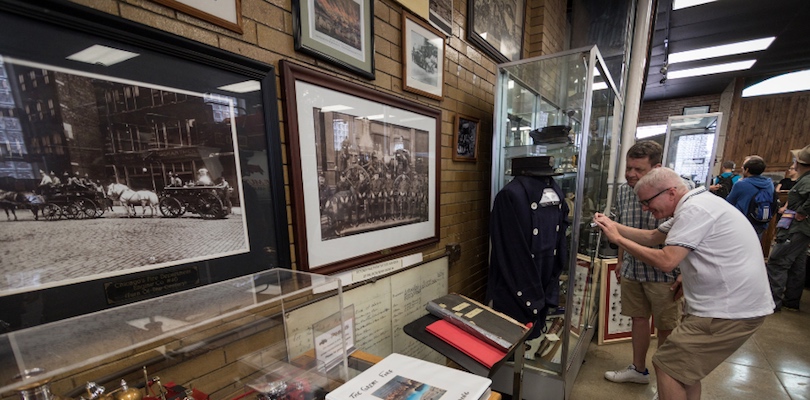
Top: Patrick Steffes Bottom: Matthew Kaplan
This tour included a special behind-the-scenes tour of the Fire Museum of Greater Chicago, celebrating its 20th anniversary in 2017 and containing a remarkable collection of memorabilia celebrating and honoring Chicago fire fighters and their long history of service and sacrifice. An excellent overview of this institution and their remarkable collection was written by the Chicago Tribune’s Steve Johnson in 2014 and may be read here.
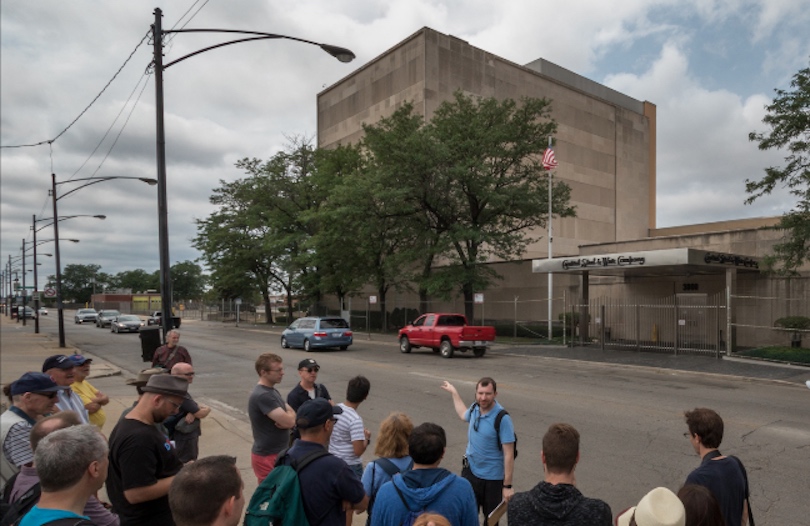
Matthew Kaplan
In the early part of the last century, Gage Park grew rapidly, with bungalows and shopping districts popping up across the community. Industry was quite prevalent as well, including light industry, machine shops and enormous factories such as Central Steel & Wire as seen above and other enterprises that located along the many railroads that criss-crossed the community. Churches were an integral part of the community as well, with many ethnicities represented.
Many thanks to those who joined us in Gage Park!
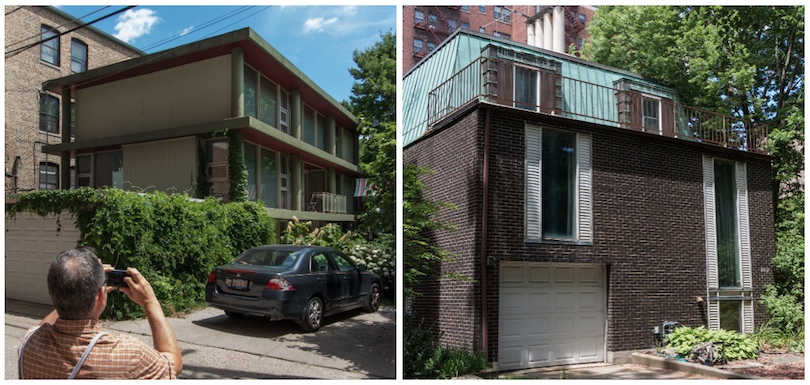
Matthew Kaplan
A sold-out group joined Forgotten Chicago on Sunday, July 9, 2017 as we explored Hyde Park for the first time since 2012 with an exclusive walking tour. Venturing far beyond the cliché (Collegiate Gothic and gargoyles), the beloved (a low-slung Prairie School house), and the familiar (a long-gone exposition and those swept up in its dark side), our exploration of Hyde Park showed an incredible array of Hyde Park’s lesser-known and often remarkable built environment from the past eight decades.
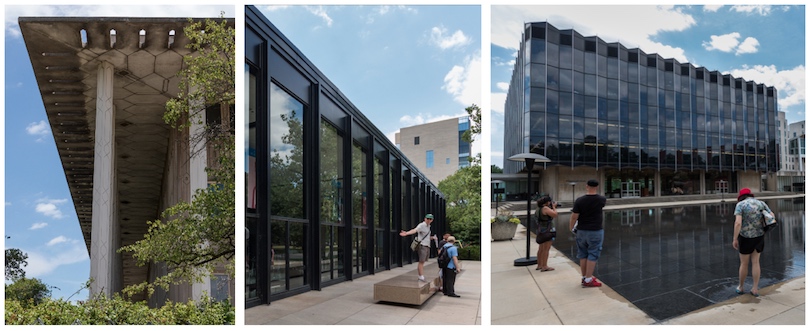
Matthew Kaplan
Architects Edward Dart, Edward Durell Stone, (above left) Edward Larabee Barnes, Helmut Jahn and Mies van der Rohe (above center) and their patrons have enthusiastically embraced (briefly, in some cases) everything from the International Style to New Formalism, Brutalism and the current preference for sustainable design. While many Hyde Park landmarks by world-renowned architects remain today, including Eero Saarinen’s Laird Bell Law Quadrangle (above right). Saarinen’s only other campus building was demolished by the university in 2002.
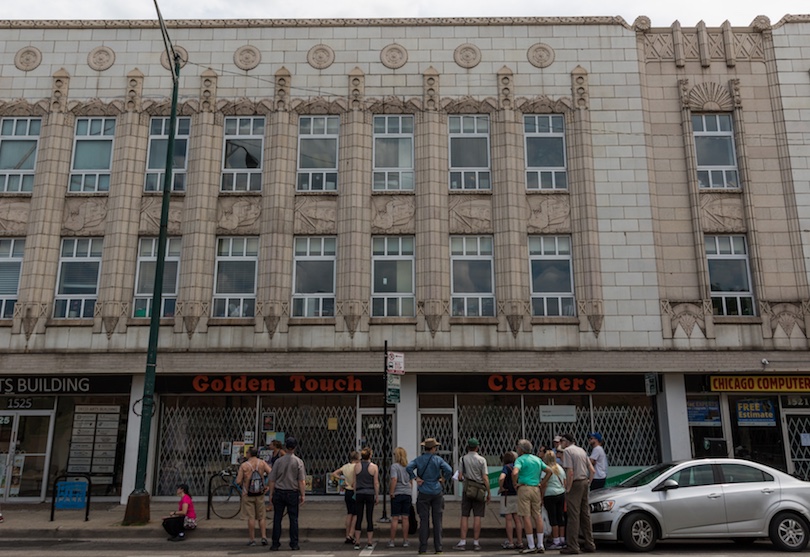
Matthew Kaplan
Subject to an enormous urban renewal program in the 1950s, Hyde Park’s once-vibrant commercial strip along East 55th Street was nearly completely demolished, with odd remnants remaining today of where old and new Hyde Park intersect. Visiting over 25 sites, we ended the tour at M. Louis Kroman’s Ritz Garage, with exuberant terra cotta celebrating automobiles and motoring on one of Chicago’s best Art Deco buildings.
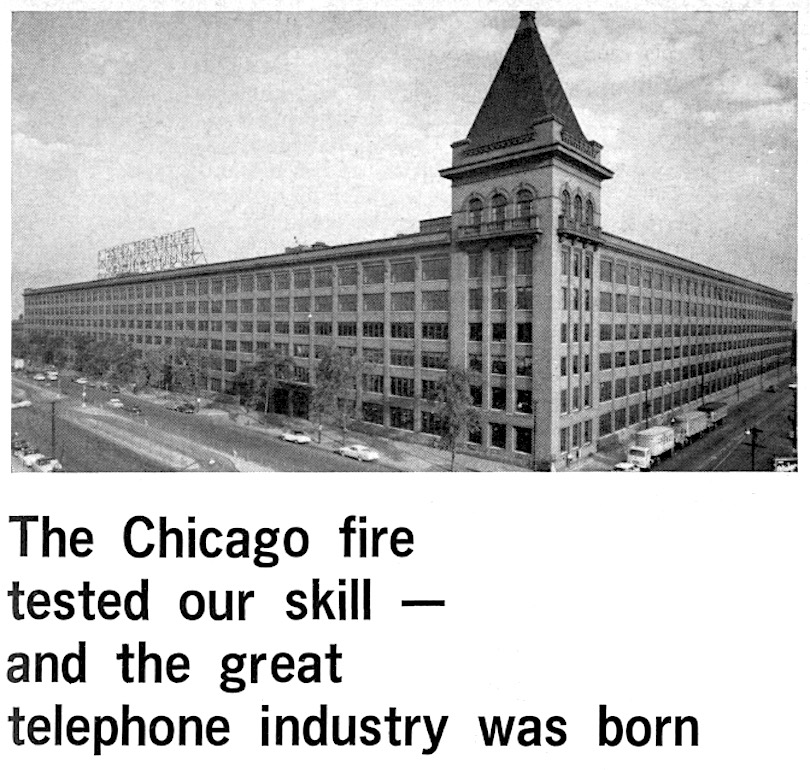
Western Electric ad, Commerce, 1965
A sold-out group joined Forgotten Chicago on a sunny summer day on Sunday, June 11, 2017 for our first tour since 2013 of the fascinating built environment of Cicero and Berwyn. Fittingly, we started at one of the few remnants of Western Electric’s once-massive Hawthorne Works at the southeast corner of Cermak Road and Cicero Avenue (shown above in 1965), and in operation from 1905 to the mid-1980s. Hawthorne Works at its peak produced nearly every telephone manufactured in the U.S. and employed no fewer than 42,000 people in an enormous complex 1 ½ times the size of Chicago’s Merchandise Mart. Visit this link for a comprehensive history of the Hawthorne Works site.
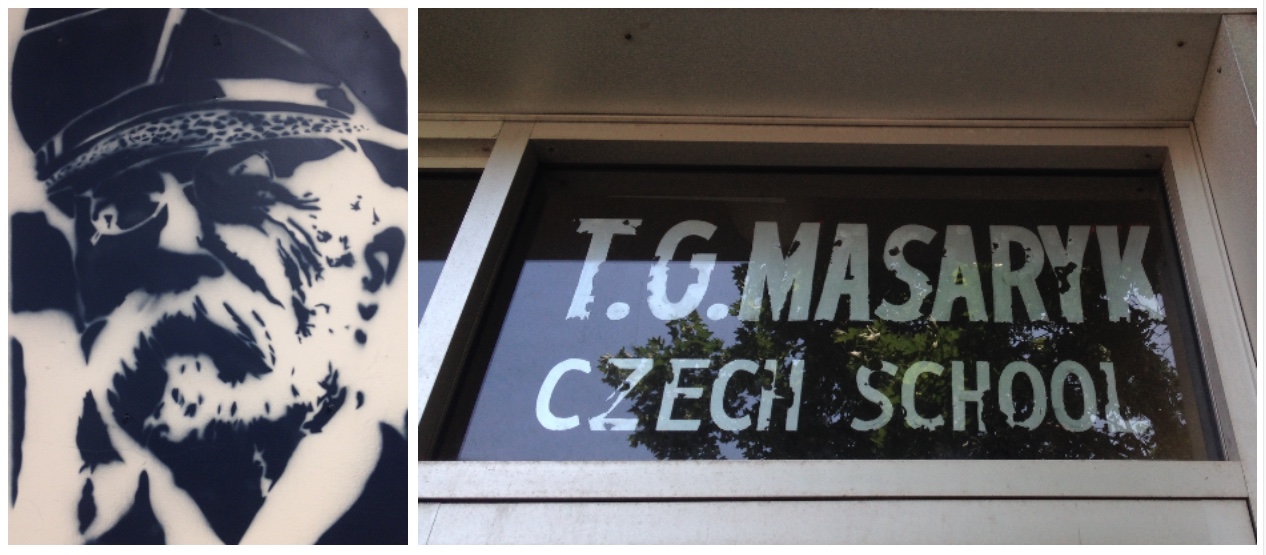
Patrick Steffes
This tour also explored the many remnants of Cicero and Berwyn’s rich ethnic history as one of the world’s largest settlements of Czechs and Slovaks. As a special treat, we were joined by two instructors at the T.G. Masaryk Czech School, continuing the tradition of these immigrants enormous contribution to these communities, and were given a tour inside this thriving school named after the first president of Czechoslovakia.
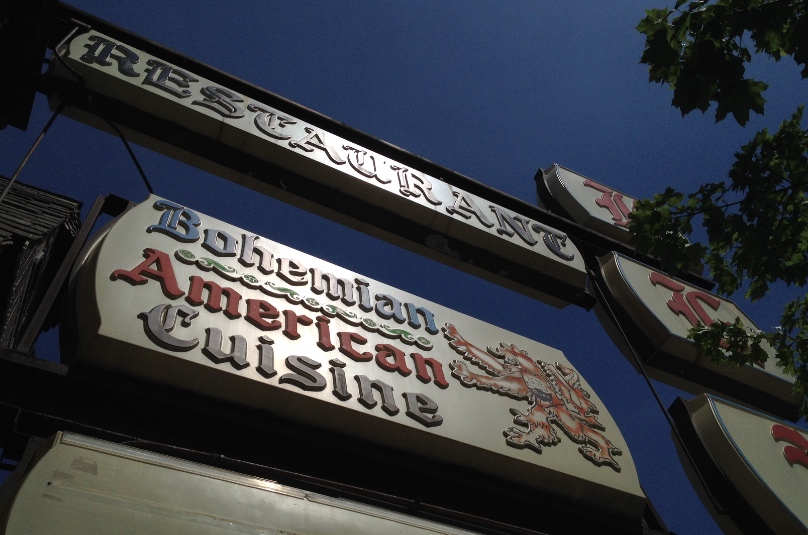
Patrick Steffes
Also explored were buildings related to the “Bohemian Wall Street” along Cermak Road, remarkably intact storefronts from the 1920s and 1930s, former movie theaters, the large array of commercial buildings from the middle of the twentieth century, and the growing Hispanic community. Appropriately, we ended the tour outside of Klas Restaurant, a beloved Cicero institution with a stunning building and interior. While Klas appears to have closed in 2016, it is our hope that this remarkable institution can reopen soon.
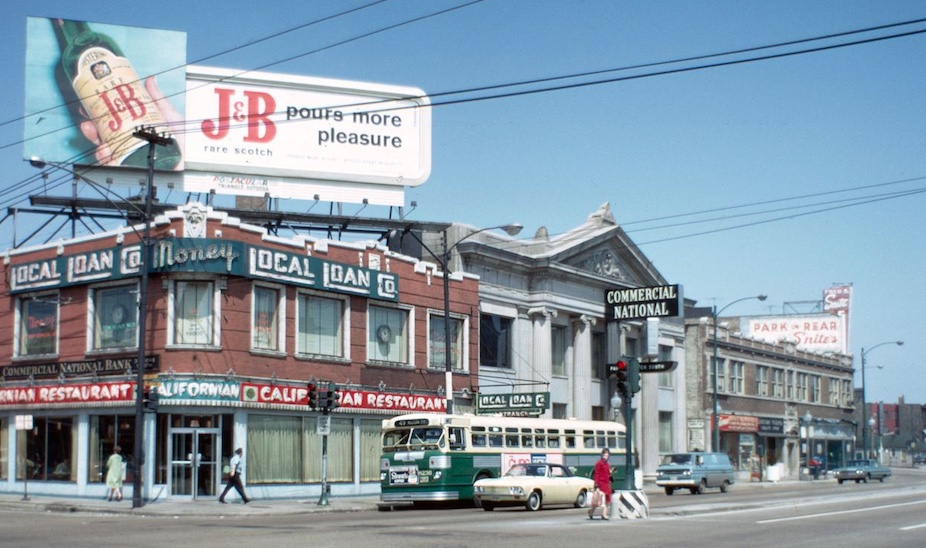
C. William Brubaker Collection (University of Illinois at Chicago), 1967
Seventy people joined Forgotten Chicago for a free and all-new presentation on Tuesday, June 6, 2017 on the rich history of Albany Park, held at the neighborhood’s namesake library branch. Exploring the built environment and history of this North Side community, we looked at many neighborhood landmarks hiding in plain site, including the former Commercial National Bank (now MB Financial Bank) at the corner of Western and Lawrence. Now buried in a later addition, the bank’s peaked roof can clearly be seen in aerial views and from the Walgreens across the street.
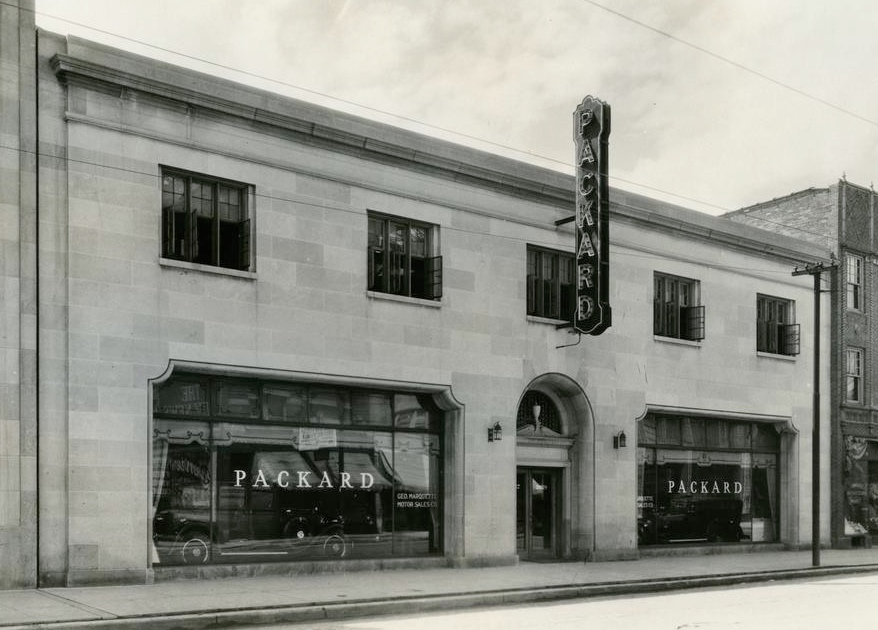
Building a Nation: Indiana Limestone Photograph Collection, Indiana University
The lively commercial heart of Albany Park then and now is Lawrence Avenue, once containing a large number of automobile showrooms. Zook & McCaughey, best known for the Pickwick Theater in Park Ridge and many eclectic homes in Chicago’s western suburbs, also designed several little-known commercial buildings, many of which have been discovered by Forgotten Chicago in recent years. Although the Packard brand disappeared in 1958, this deluxe former auto salon remains nearly completely intact today.
Many thanks to the large group who joined us in Albany Park!
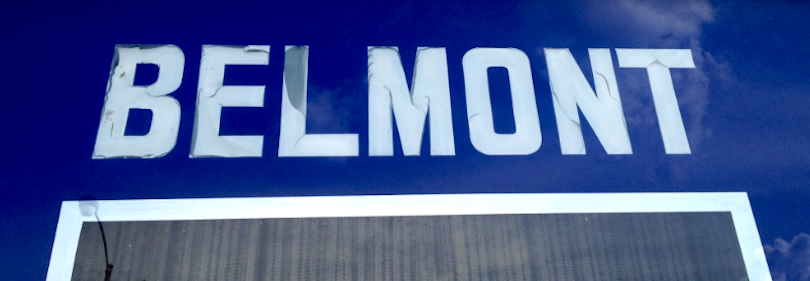
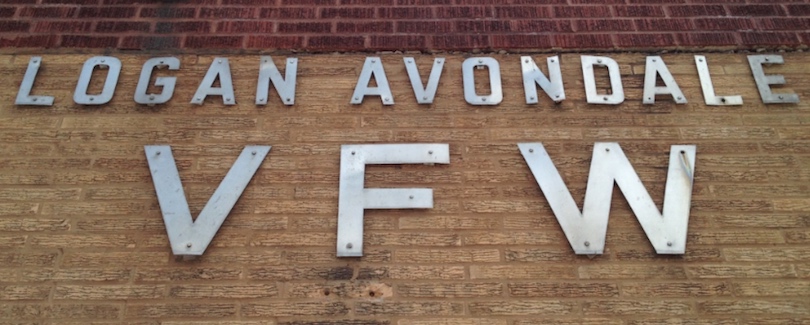
Patrick Steffes
A sold-out group joined Forgotten Chicago on Sunday, June 4, 2017 for an all-new tour examining the curious community of East Avondale in an all-new tour, examining the neighborhoods once known as Bricktown, California Park, Little Cassubia, and California Park along the Chicago River in the eastern reaches of the Irving Park and Avondale community areas. We also looked at remnants from the area’s early history as a crossroads of water and rail transport, as well as visit sites connected to the growth and evolution of this overlooked nook of Chicago’s Northwest Side.
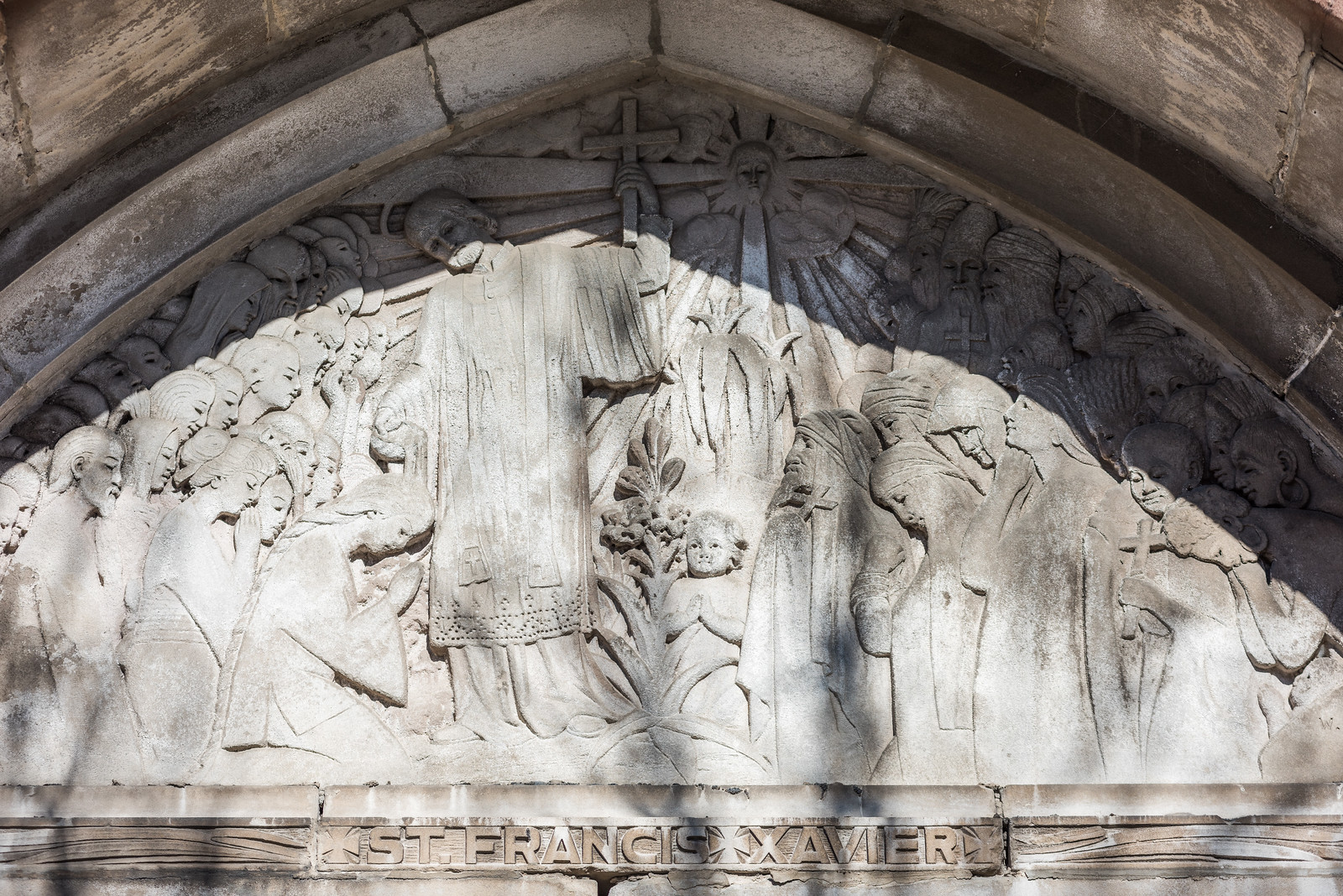
This tour also discussed this area’s industrial and ethnic history, historic homes, a forgotten elevated railroad, a massive former beer garden turned into city park, overlooked religious buildings and hiding-in-plain-sight remnants and curiosities. Many thanks to those who joined us in East Avondale!

Courtesy of WGN Radio
The Forgotten Chicago crew was honored to appear in two segments on one of the nation’s leading radio stations, WGN 720, in spring 2017. The first segment, hosted by Dave Plier and originally aired on Sunday, April 30, 2017 featured Jacob Kaplan and Patrick Steffes, and may be heard here.
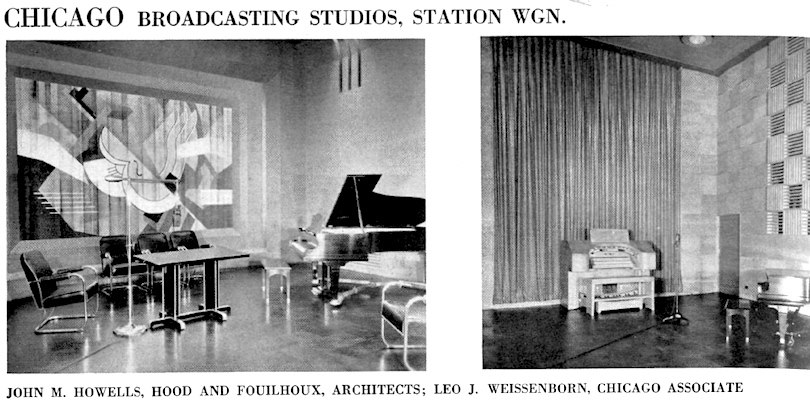
Architectural Forum, 1936
The second WGN Radio segment aired live on the Bill Leff and Wendy Snyder Show on Wednesday, May 10, 2017 and featured Jacob Kaplan, Patrick Steffes and Dan Pogorzelski. This entertaining segment may be heard here.
While today’s broadcasting studios are more utilitarian than the ones from the 1930s, WGN’s 50,000 watts continue to reach an enormous audience throughout the Midwest. Many thanks to the producers and staff of WGN Radio!
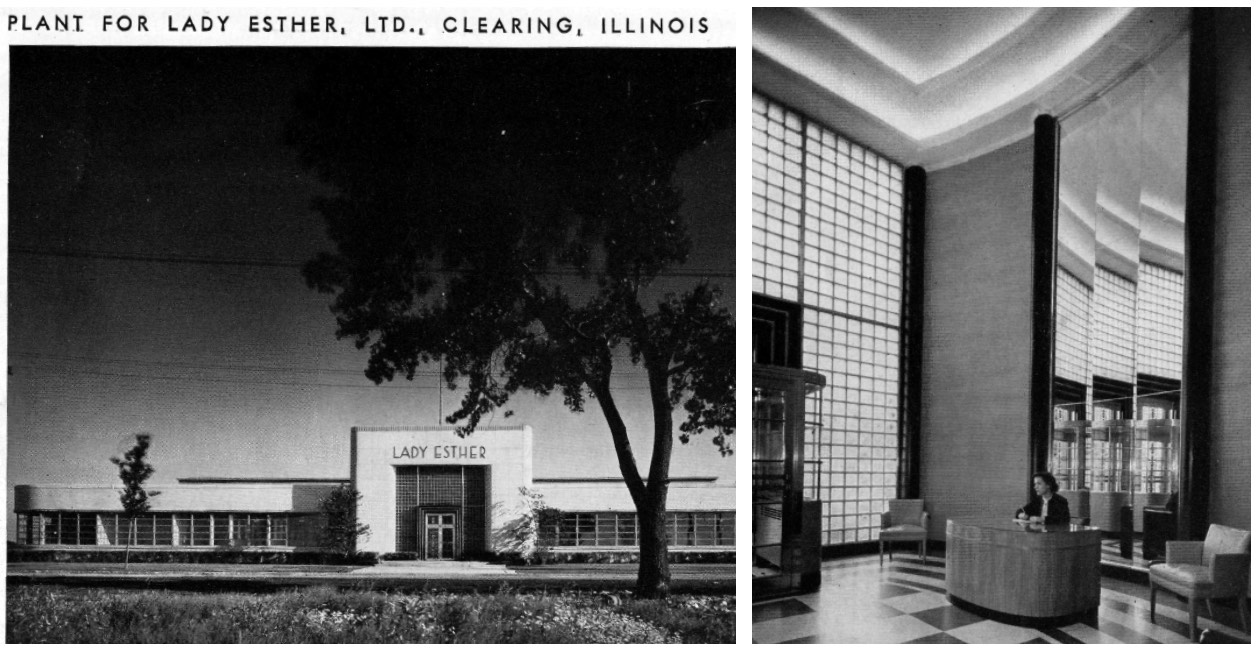

Top: Architectural Forum, 1938 Bottom: Google Street View, 2016
A group of 60 guests joined Forgotten Chicago on Wednesday, May 10, 2017 for a free presentation on the fascinating history of Clearing and Chicago’s Southwest Side. Presented for the first time since 2011 and containing many new images from our ever-growing and exclusive research database, we showed how this often-overlooked area has been crucial in the development of the Chicago region’s multi-billion dollar global economy.
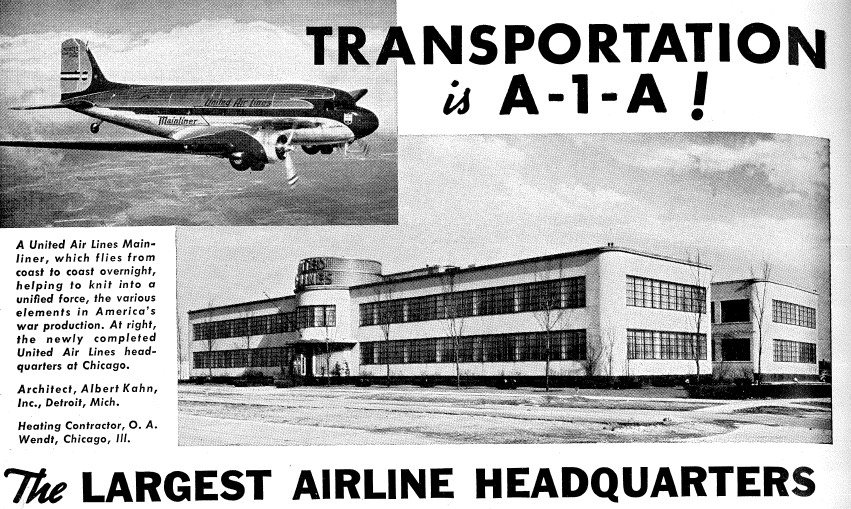
Top: Architectural Forum, 1942
Celebrating it 90th anniversary in 2017, what is now known as Midway International Airport has had an immense influence in Clearing, the Southwest Side, and American civil aviation. Another Albert Kahn one-time landmark, this massive (at the time) headquarters for United Airlines on Cicero Avenue was demolished in the late 1990s for the reconstruction of Midway.
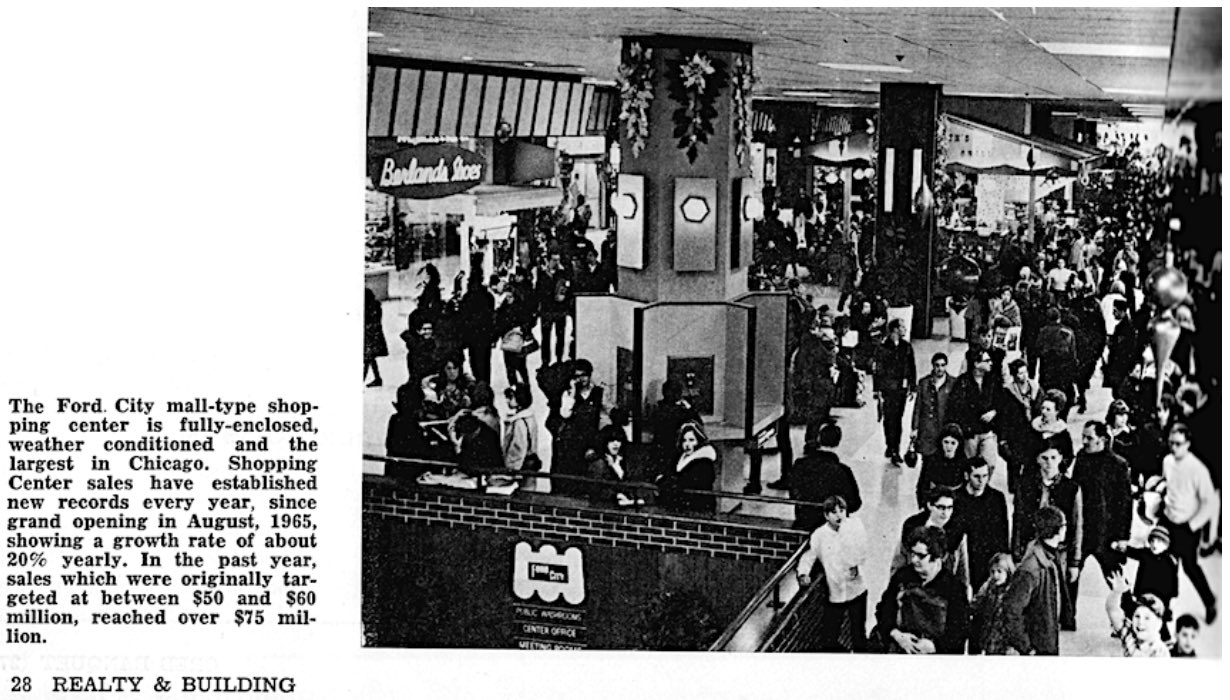
Realty & Building, 1970
Yet another Albert Kahn design, the massive Dodge Chicago Plant was the world’s largest building ever constructed when it was completed in the early 1940s, and was a vital component of Allied World War II defense production. Purchased by innovative businessman Harry Chaddick and opened as Ford City Mall in 1965, this retail power center was visited during a Forgotten Chicago tour in 2012. For more on Harry Chaddick’s Chicago legacy, visit this site.
Many thanks to everyone who joined us in Clearing!
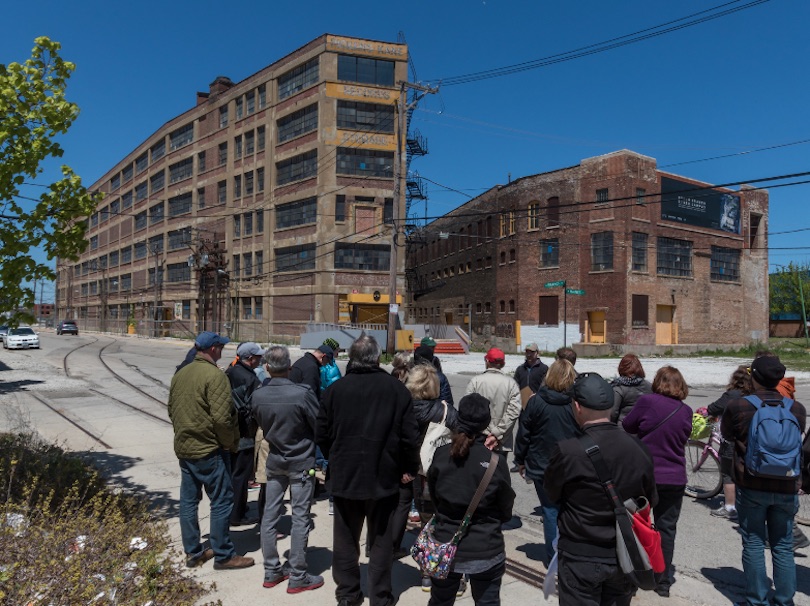
Matthew Kaplan
A sold-out group joined Forgotten Chicago on a bracing spring day on Sunday, May 7, 2017 for a reprise of our exclusive tour exploring the remnants of Ogden Avenue. One of the most peculiar chapters in Chicago transportation history, Ogden Avenue was researched by Forgotten Chicago for an article published in 2009. A major arterial street that was extended from Union Park to Lincoln Park at enormous expense and disruption in the 1930s, the extension of Ogden was closed in stages starting in 1967.
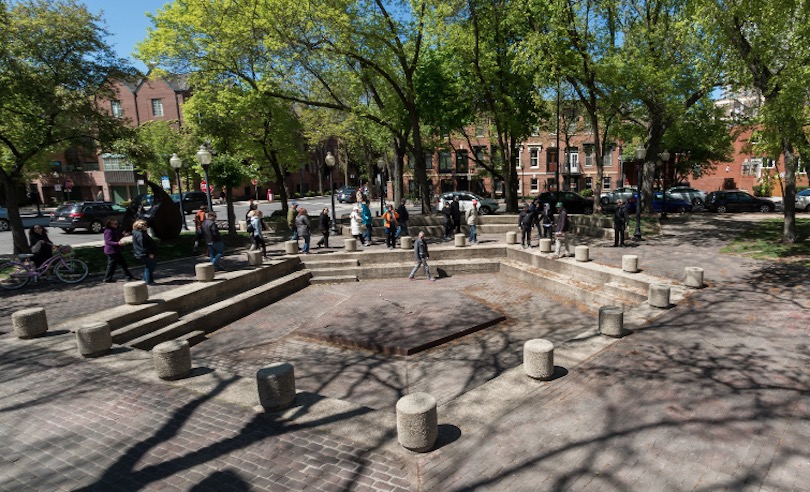
Matthew Kaplan
While the long-gone sections of the former Ogden Avenue are largely forgotten, this tour examined its numerous remnants through the Near North Side, including Richard J. Daley-era public space and oddly positioned housing and religious buildings. The more than 100-foot wide vacated right of way of Ogden Avenue in an established urban neighborhood allowed for a unique collection of 20th century homes by noted architects including Stanley Tigerman, Larry Booth, and Walter Netsch.
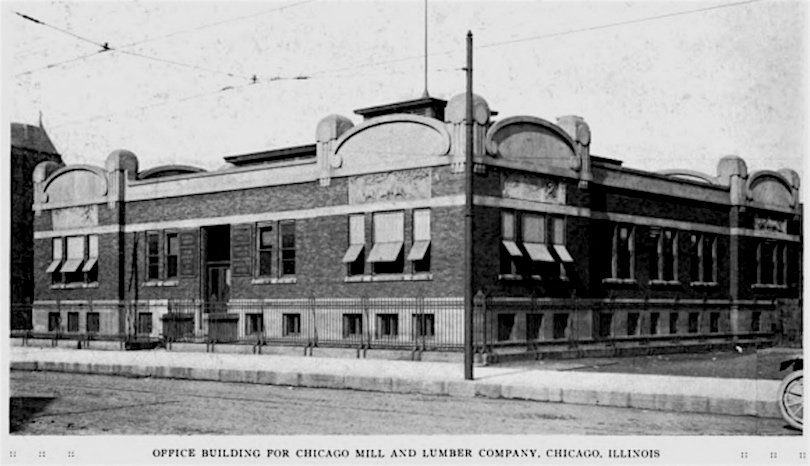
Western Architect, 1915
The many oddballs and oddities on and near the route of the former Ogden Avenue were also examined, including the nearly completely intact former lumber company office building that surrounds an 1870s Italianate house. The original roofline and cupola of this buried house may be seen in both the image published in 1915 and (at least for now) in 2017.
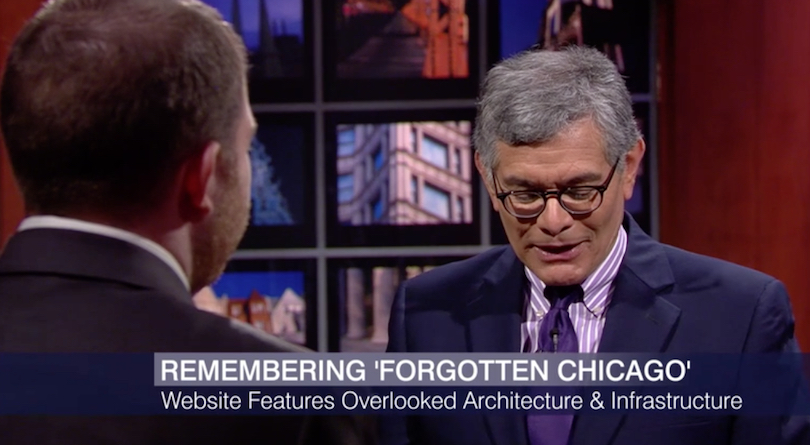
Courtesy of Chicago Tonight, WTTW
On April 20, 2017, Phil Ponce of WTTW’s Chicago Tonight interviewed Co-Founder and Editor Jacob Kaplan for a segment on the tenth anniversary year of Forgotten Chicago researching, writing and exploring the Chicago area’s overlooked built environment. This entire segment may be seen here. Many thanks to Phil Ponce and the producers of Chicago Tonight!
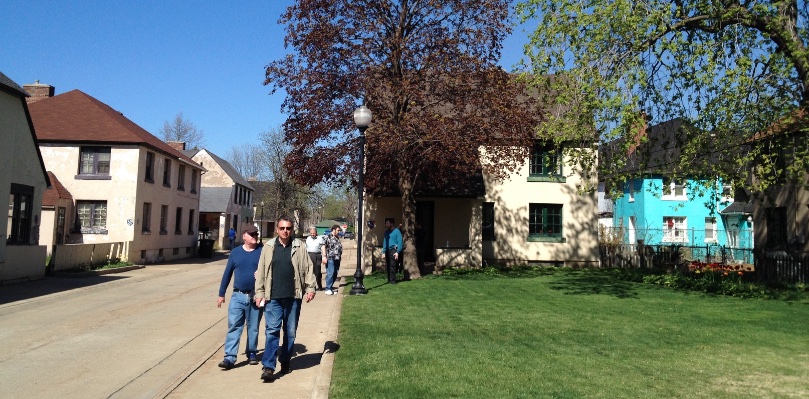
Patrick Steffes
A sold-out group joined Forgotten Chicago on a glorious spring day on Sunday, April 23, 2017 as we explored by bus the often overlooked, but fascinating, Calumet Region of Illinois and Indiana, telling the story of one of the most productive industrial regions in the world. The Calumet Region, Chicago’s “industrial downtown,” is filled with ethnic and industrial history, as well as surprising architectural oddities. Offered for the first time since 2013 and visiting many sites associated with the former Standard Oil Company of Indiana, guests also received a unique souvenir – a piece of some of the 700,000 square feet of white Italian Carrara marble that was installed (and removed) from their former corporate headquarters at 200 East Randolph in Chicago.
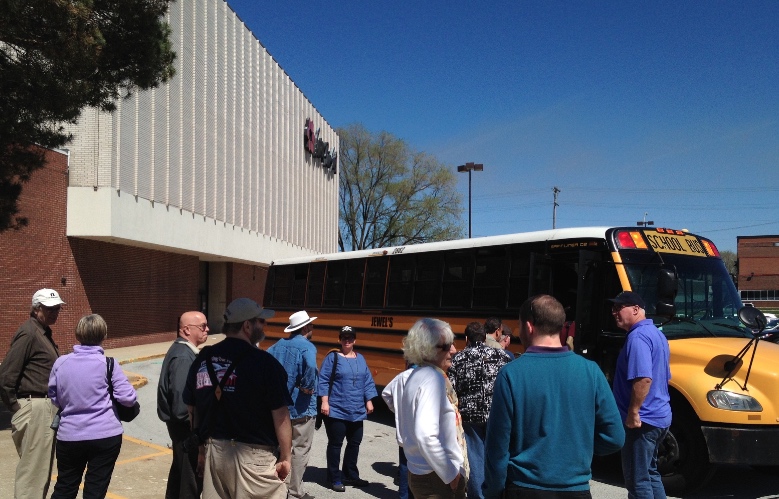
Patrick Steffes
No visit to the Calumet Region is complete without a visit to the site of the former Woodmar Shopping Center in Hammond, designed by famed shopping center architect Victor Gruen and one of the earliest in the region when it opened in 1954. While the shopping mall portion of this complex was demolished in 2006, the unique five-sided Carson Pirie Scott still stands, at least for now. Along with Woodmar, this tour also pointed out other relics and unique examples of mid-century modern design, Calumet Region-style.
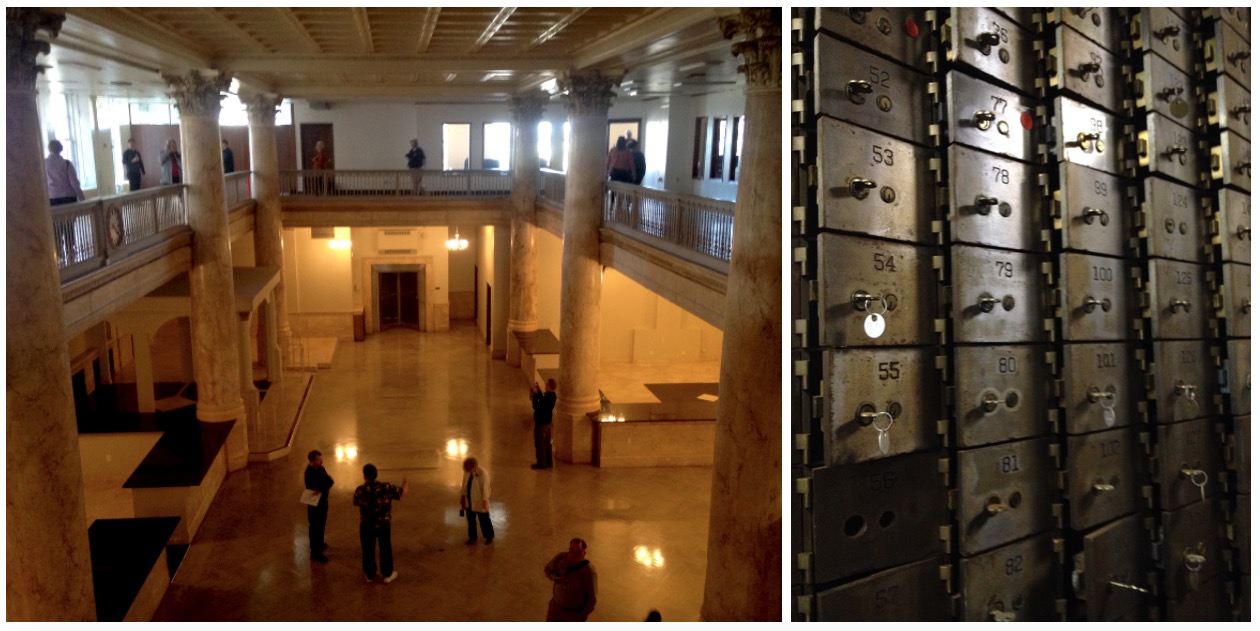
Patrick Steffes
Long-forgotten industrial sites on both sides of the state line were examined on this tour, such as the decaying but beautiful remnants of the Acme Steel coke plant in Chicago. Heading south from central Chicago into the netherworld of industrial Chicago on our trusty yellow school bus (used again for added maneuverability and to keep prices low), we also paid a visit to the stunning interior of the 1927 former Gary State Bank building, whose elegant lobby and intact vault are now used as a private event venue.
Many thanks who joined us in the Calumet Region!
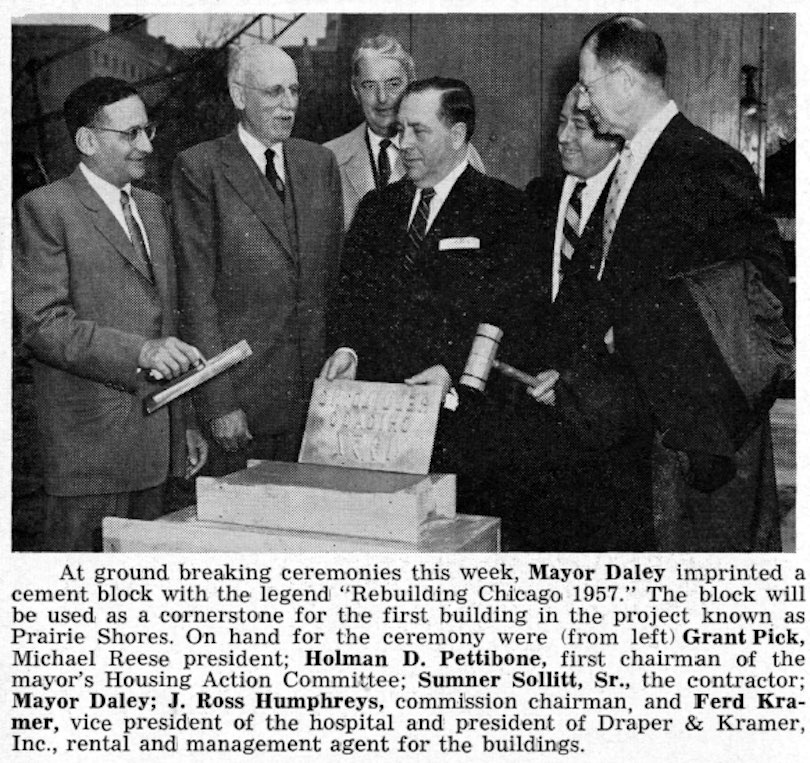
Realty & Building
A group of 45 guests joined Forgotten Chicago on March 18, 2017 for a free event as we helped celebrate the 60th anniversary of the Bezazian Branch of the Chicago Library with an all-new presentation. During this discussion, we expolored the past and present of the Uptown community, and the curious remnants of Uptown history that are hiding in plain sight. We also looked at the incredible growth and change happening throughout the Chicago region the year the Bezazian Branch opened in 1957, including building the region’s expressway and tollway system, urban renewal, and the enormous number of new housing, retail and office construction in the region. Many thanks to those who joined us in Uptown!
- Chaddick Institute Illinois Center and Lakeshore East Walking Tour on Sunday, October 24, 2021
- Chaddick Institute Cityfront Center Walking Tour on Saturday, June 18, 2022
- Docomomo Modernist Peterson Avenue Walking Tour on Saturday, October 16, 2021
- Chaddick Institute Terminal Town Walking Tour on Sunday, October 27, 2019
- Chaddick Institute Promoted Tour: The Extension and Removal of Ogden Avenue on Sunday, August 13, 2023



